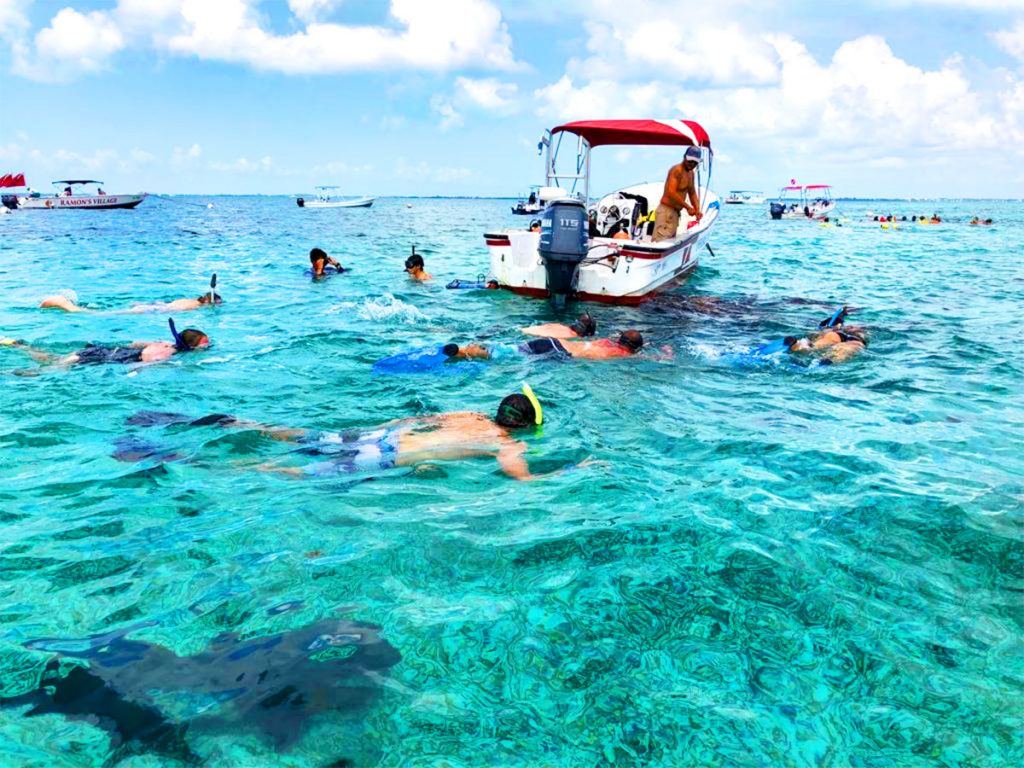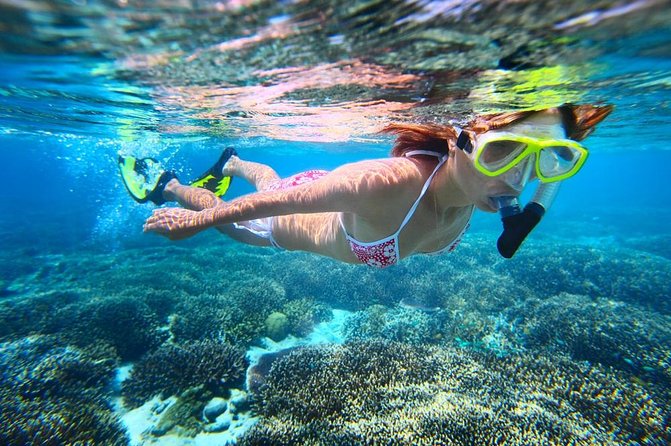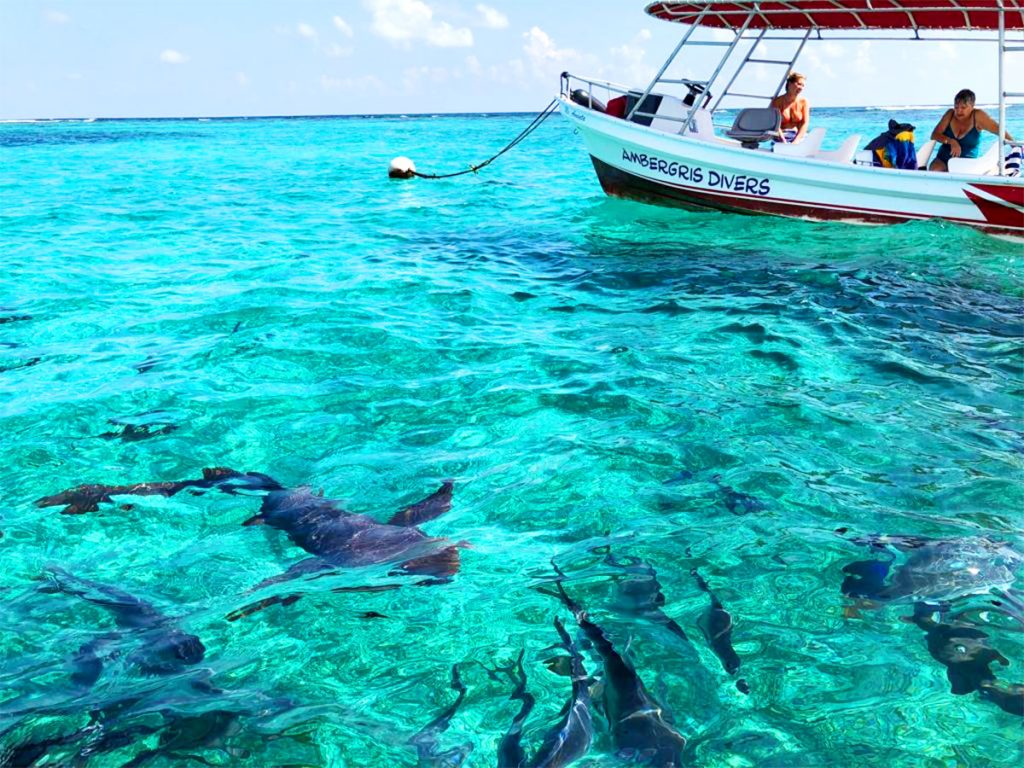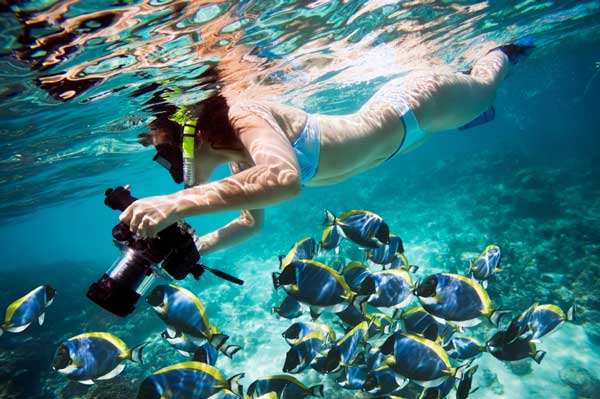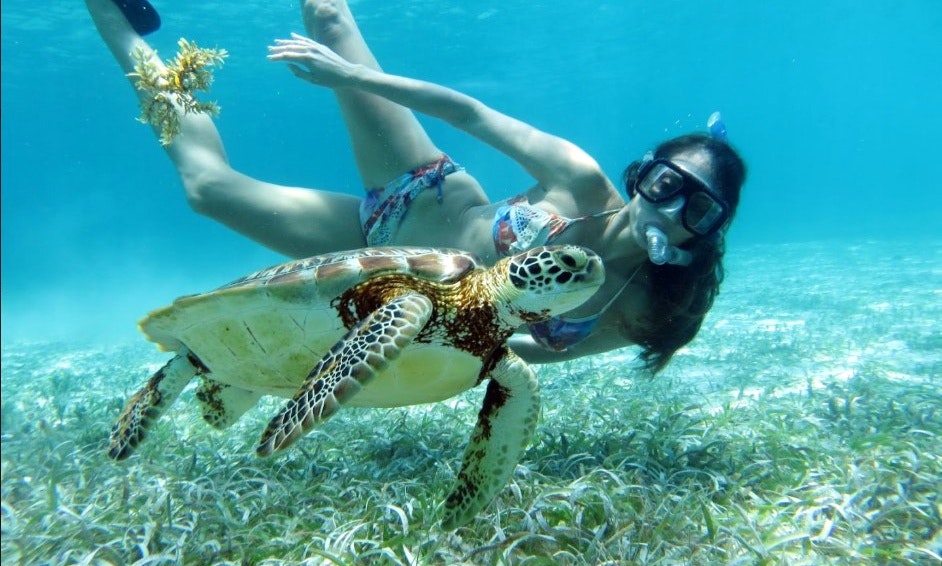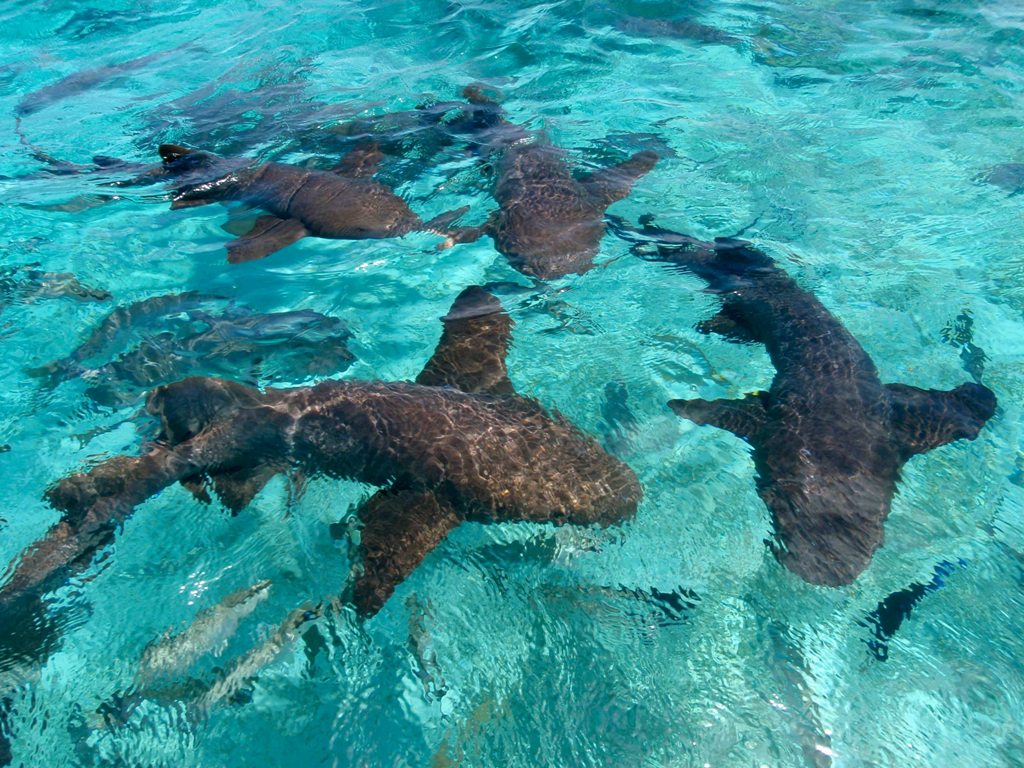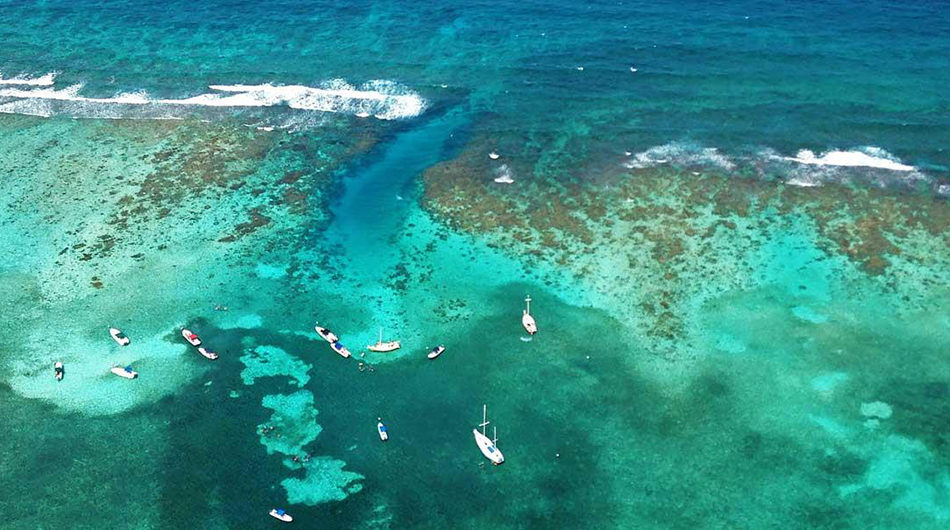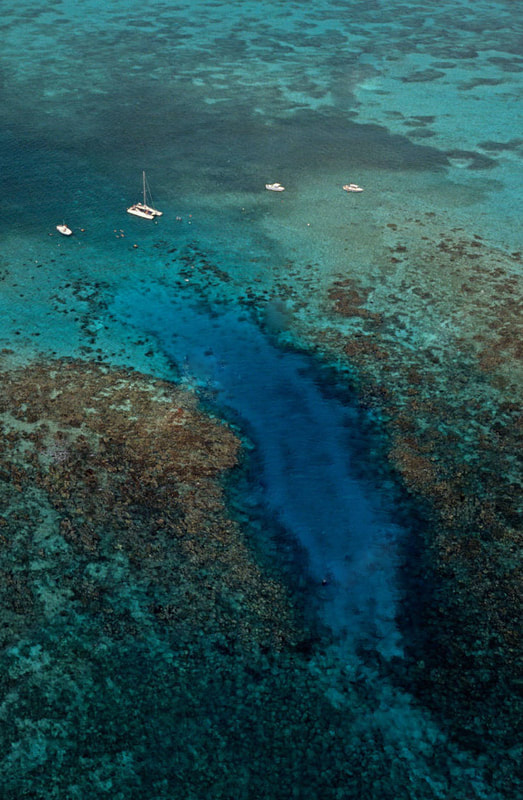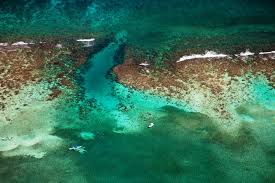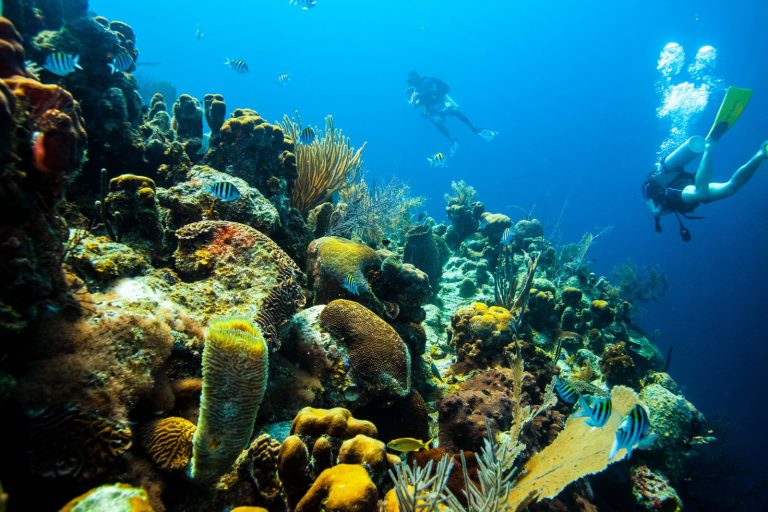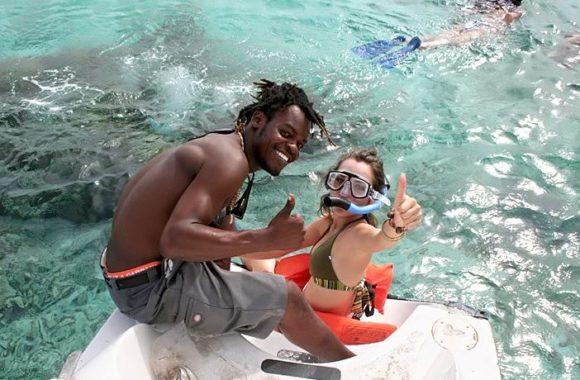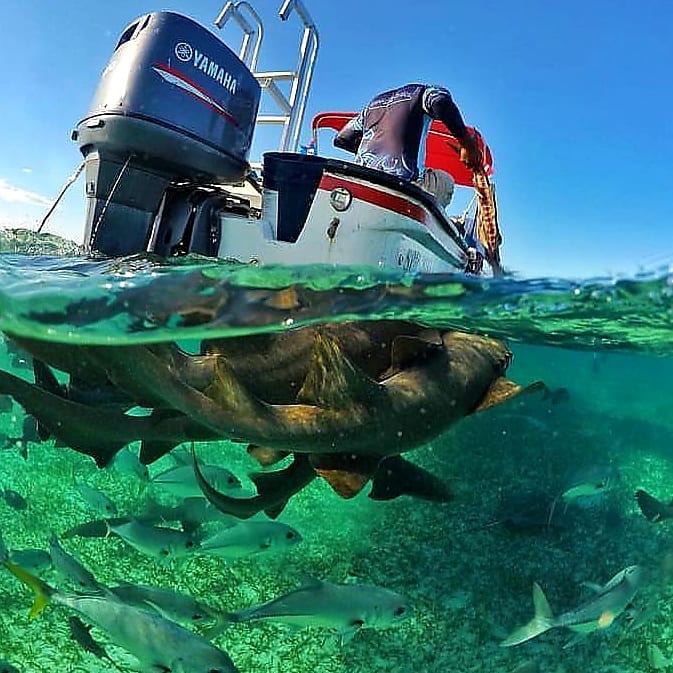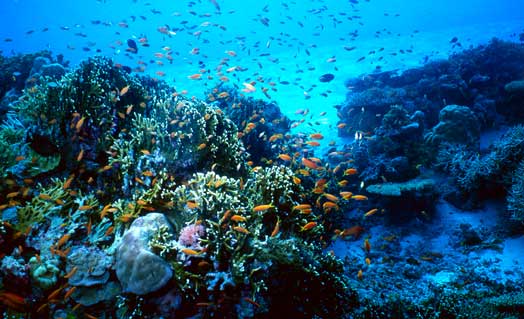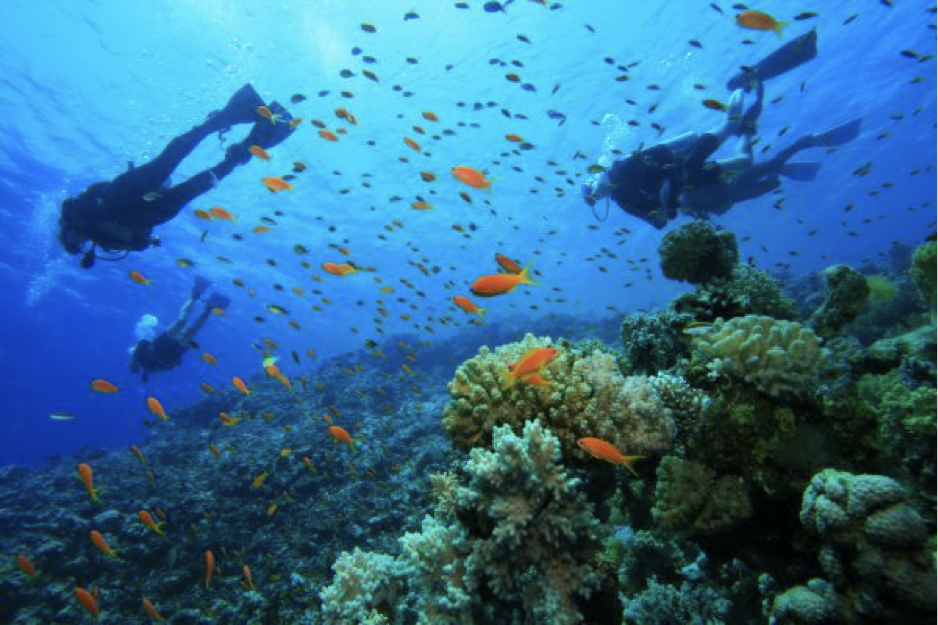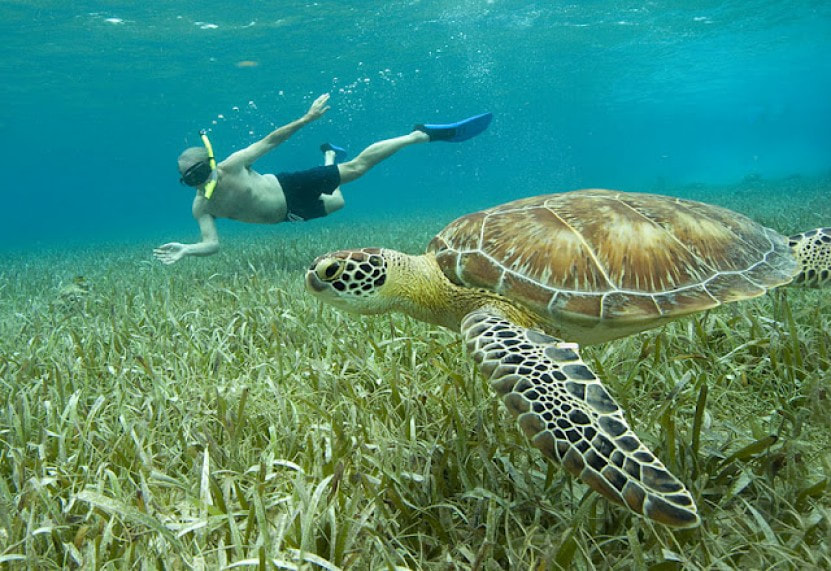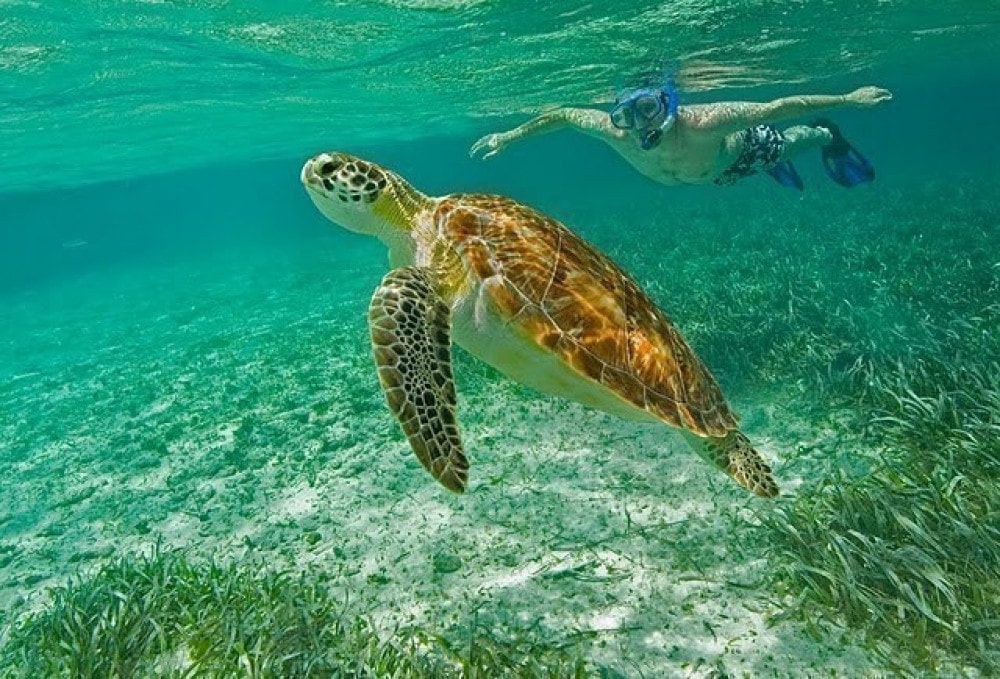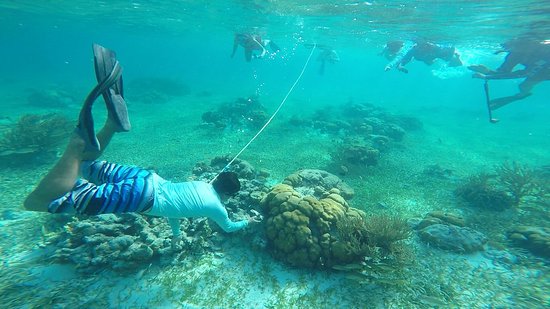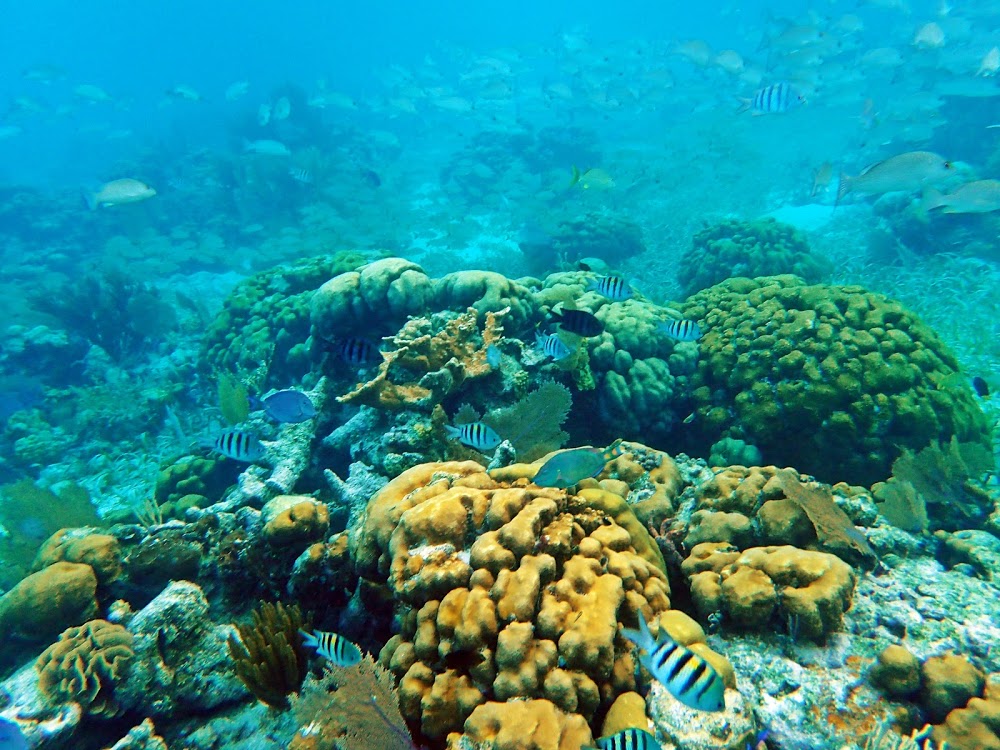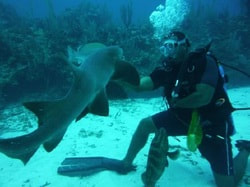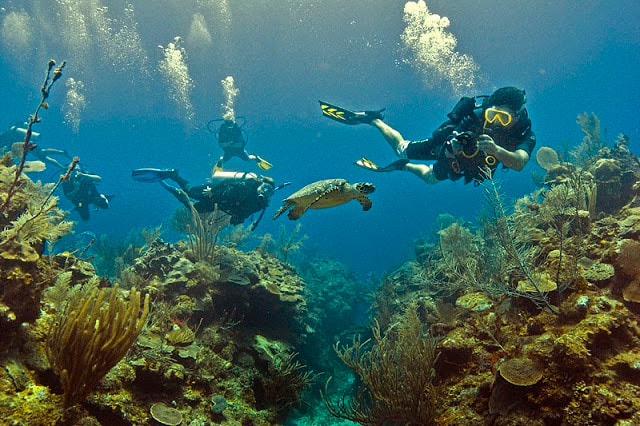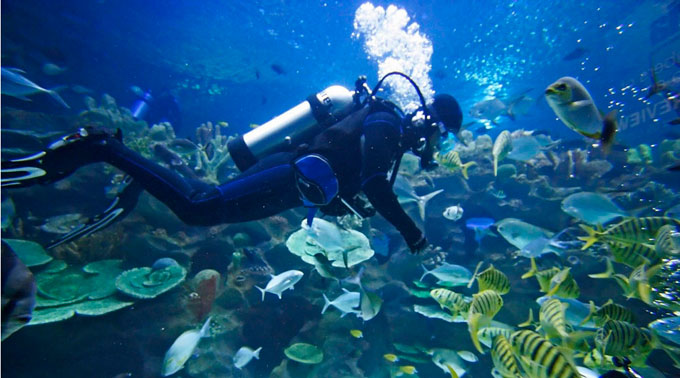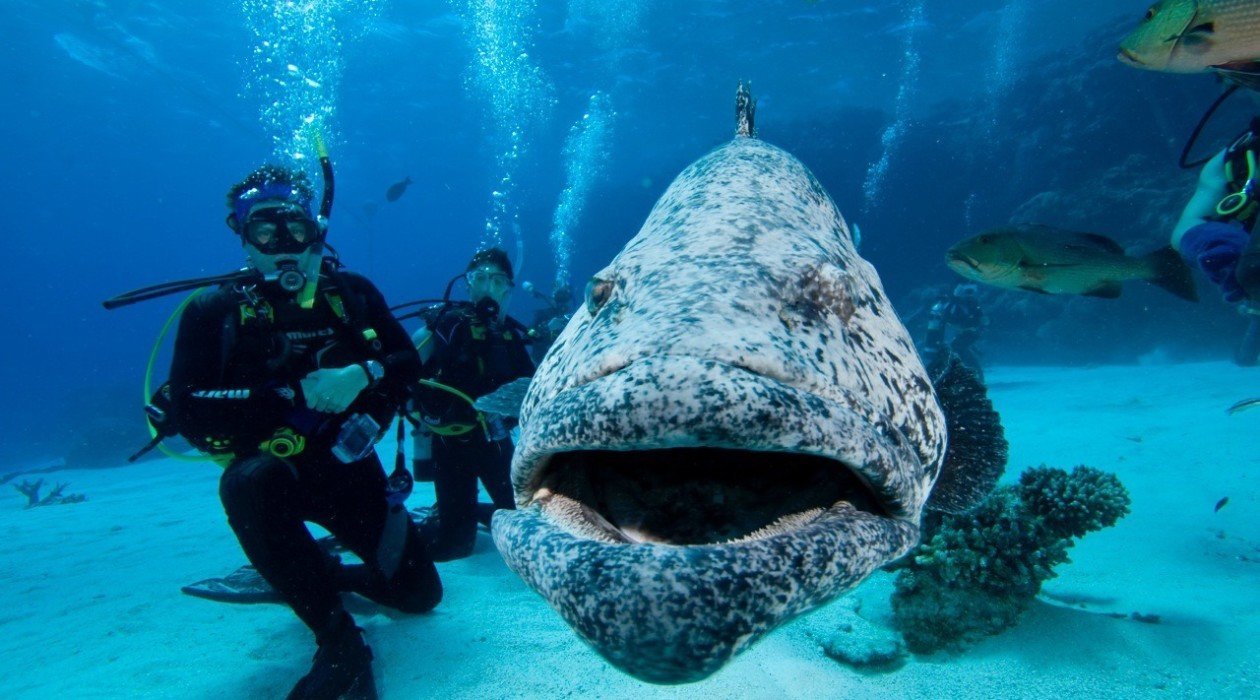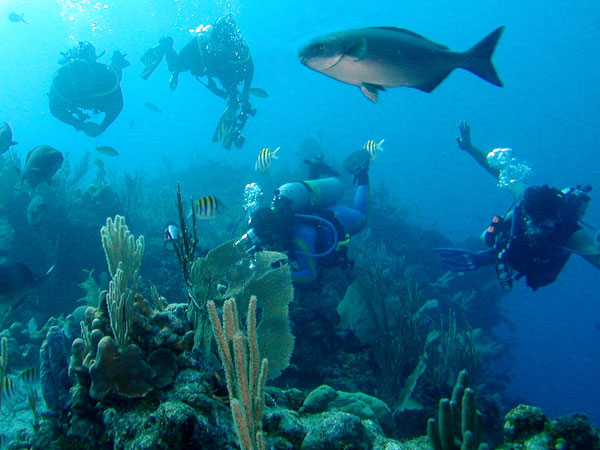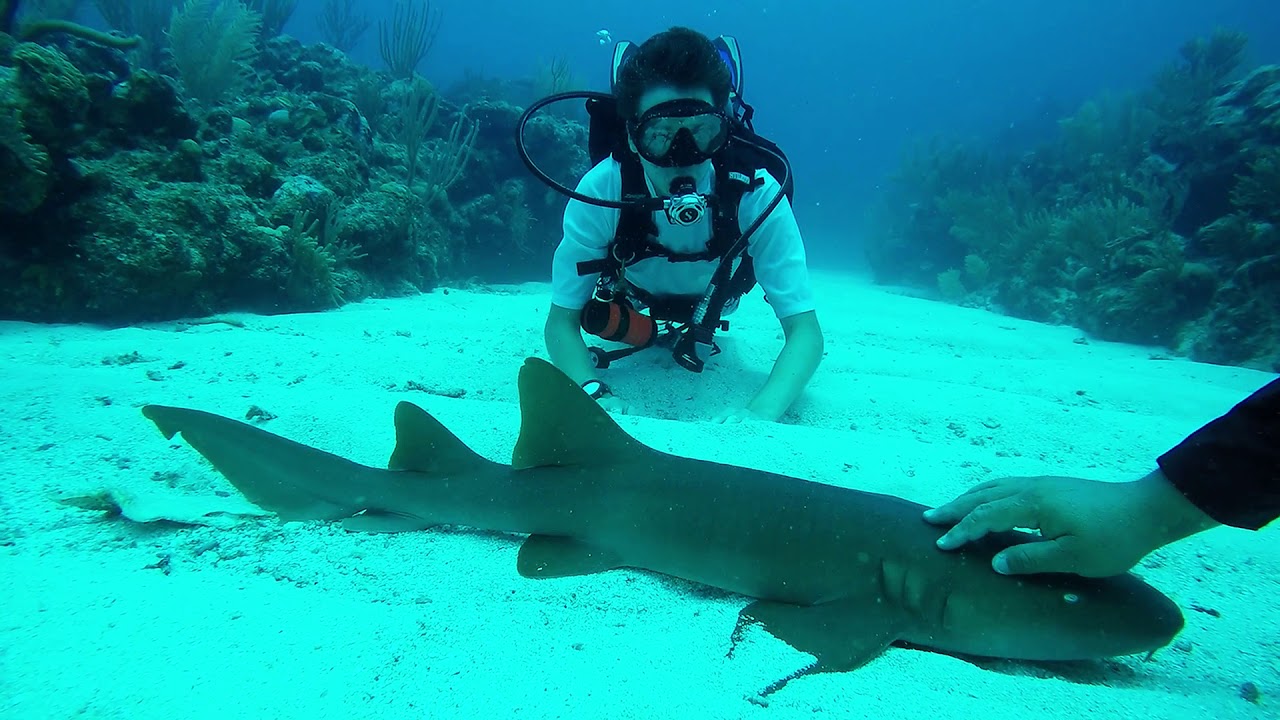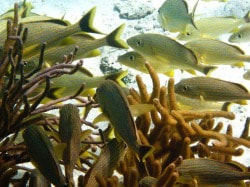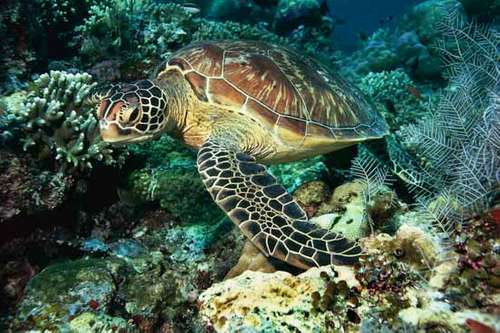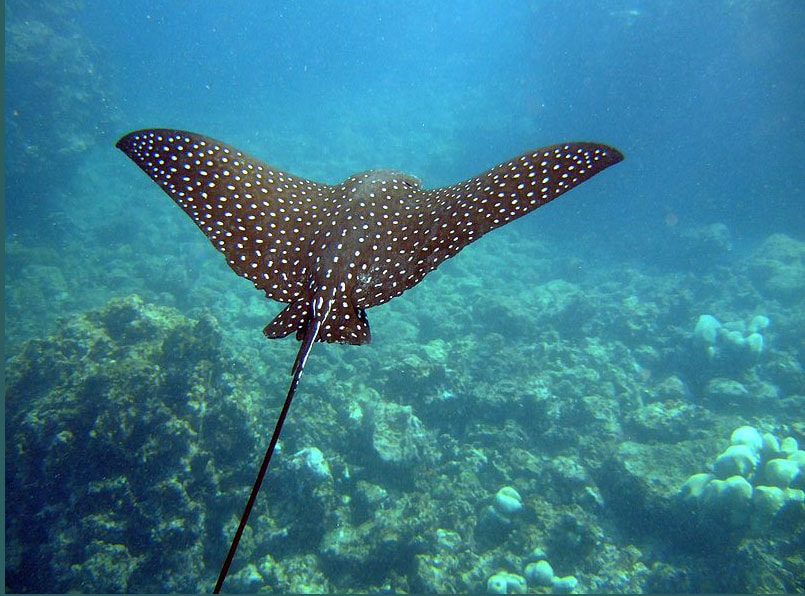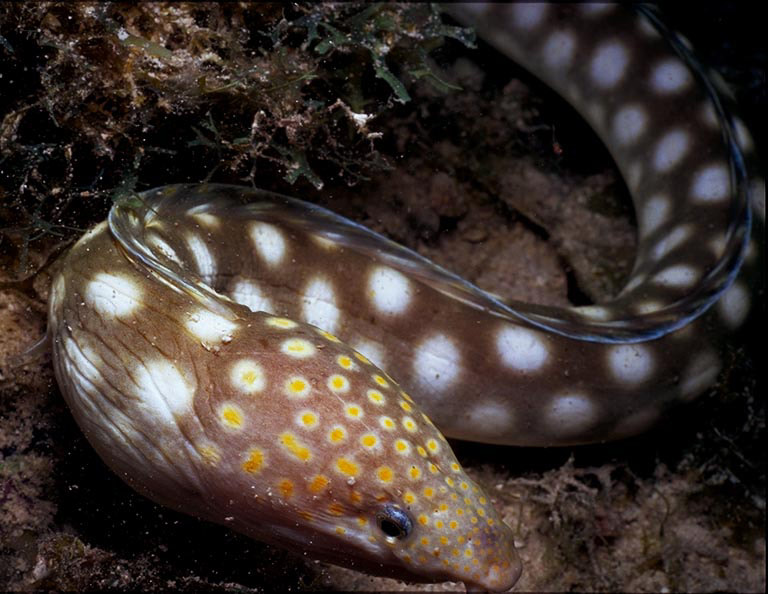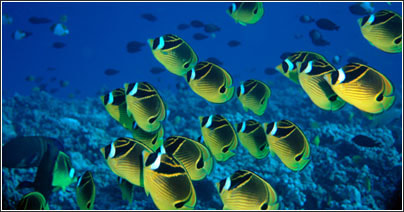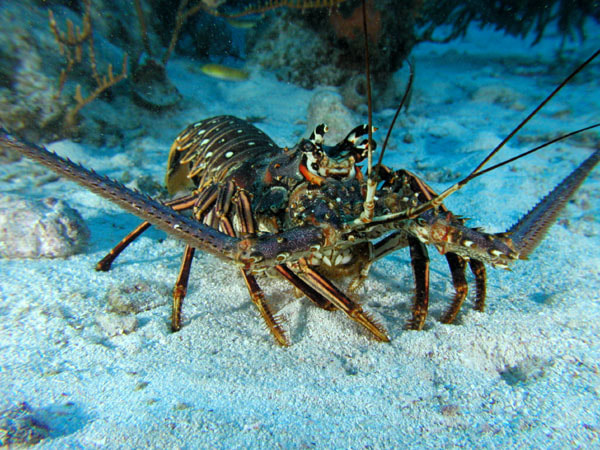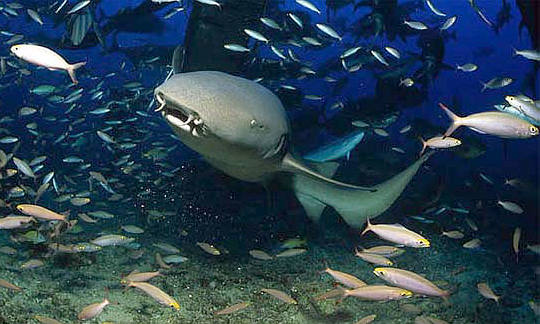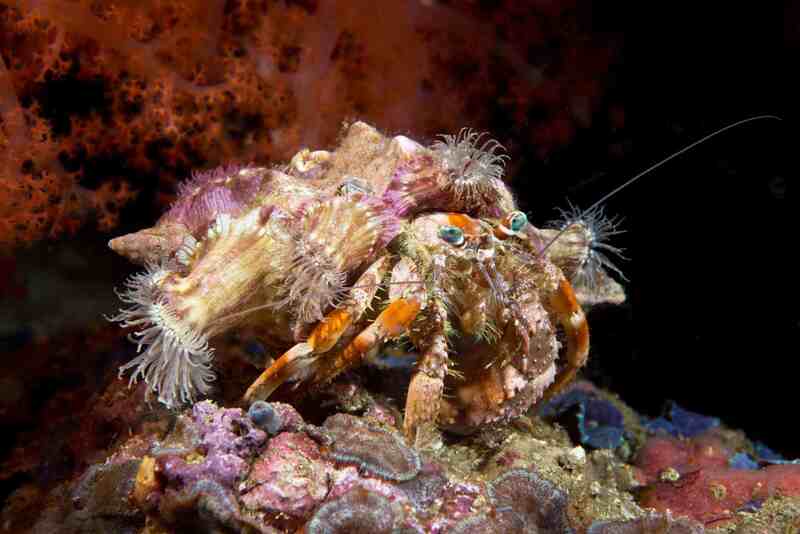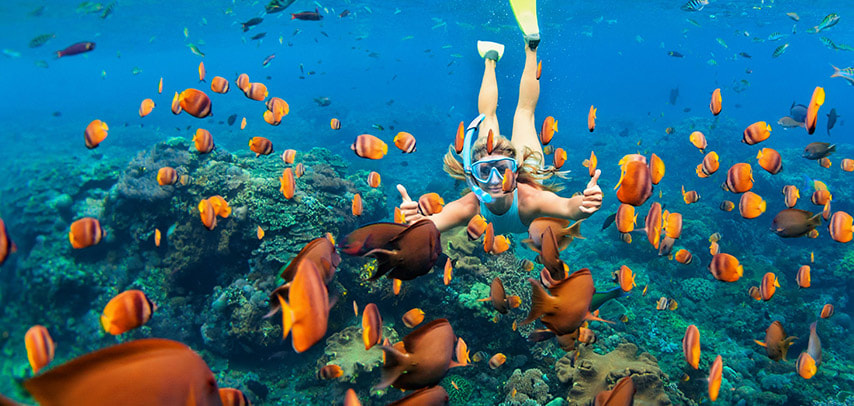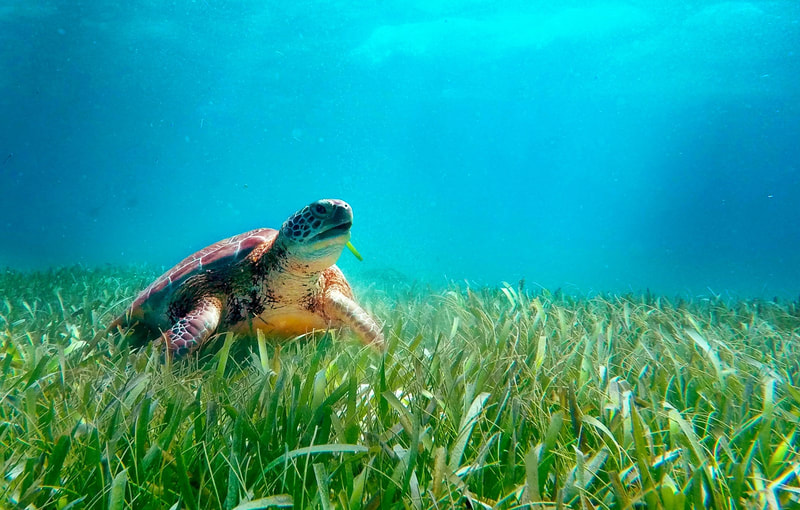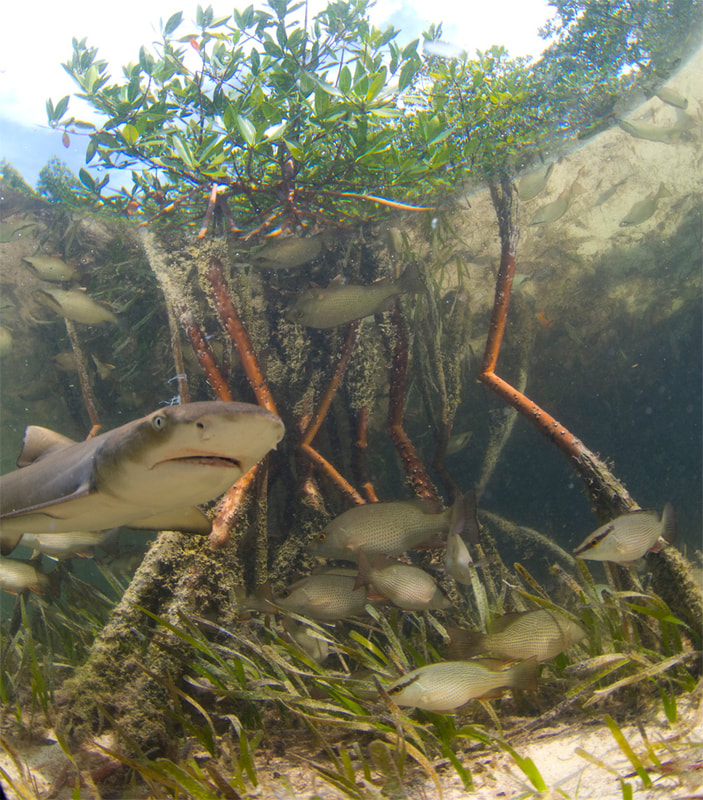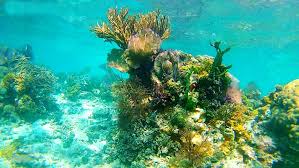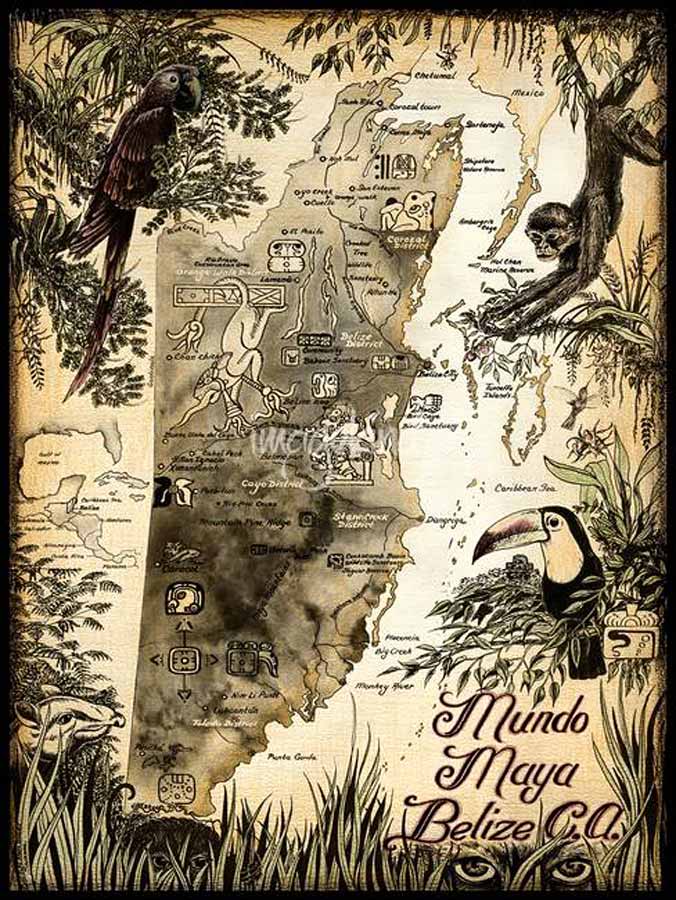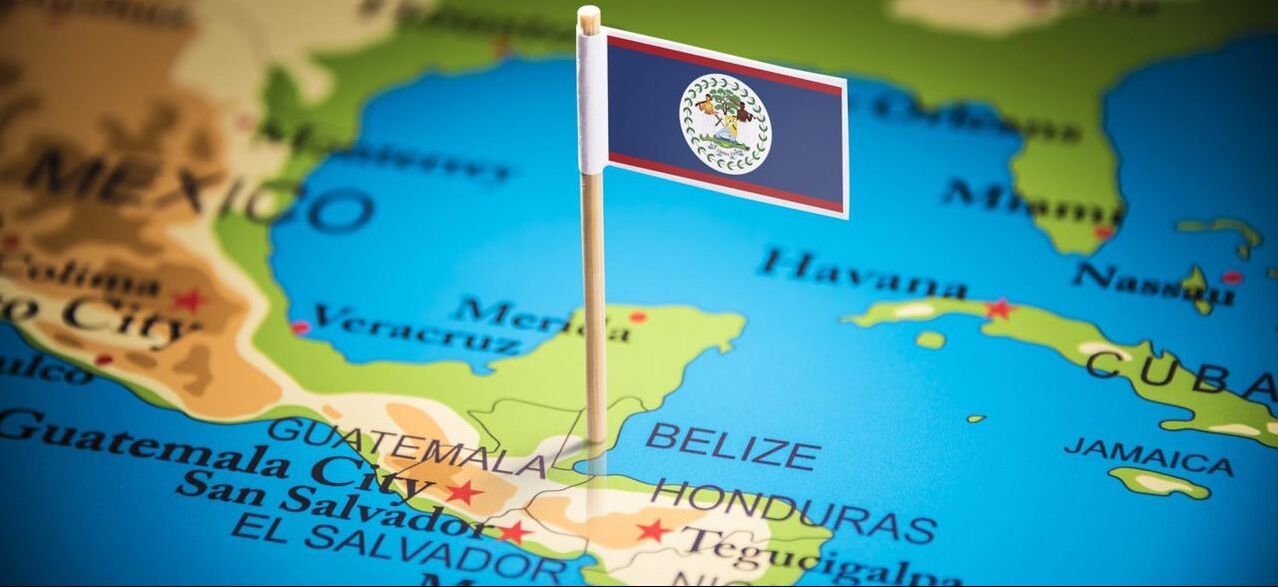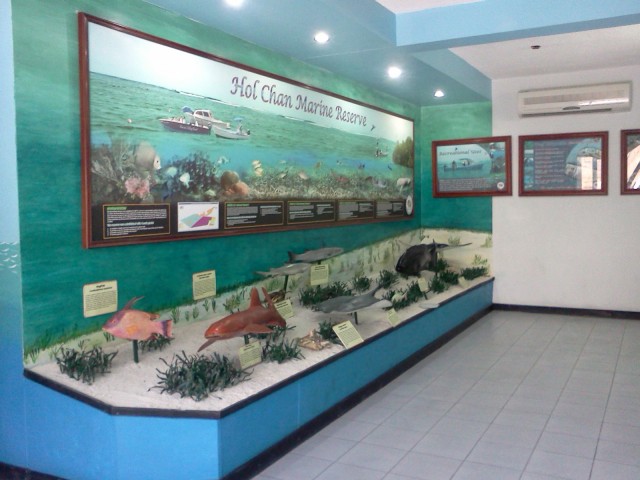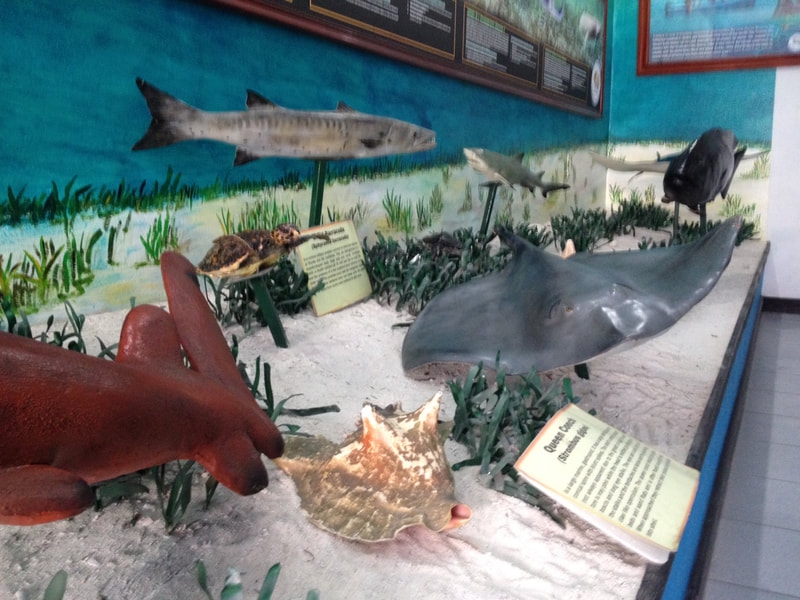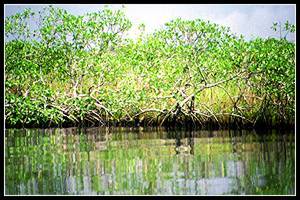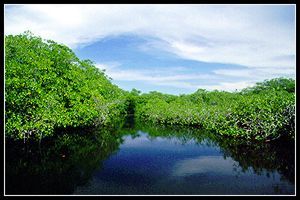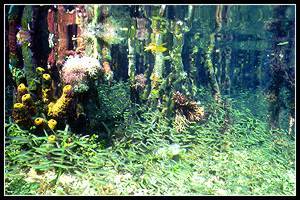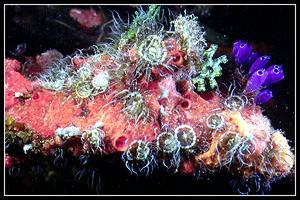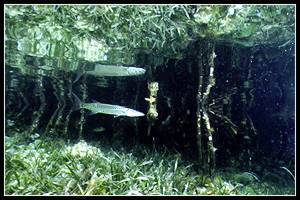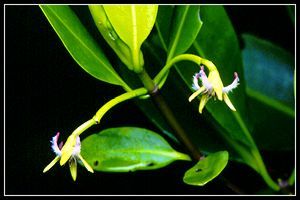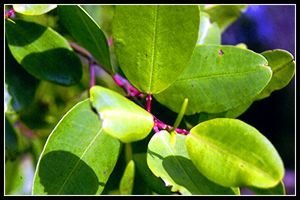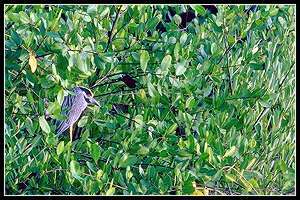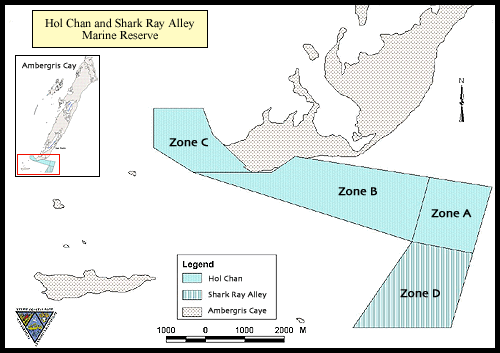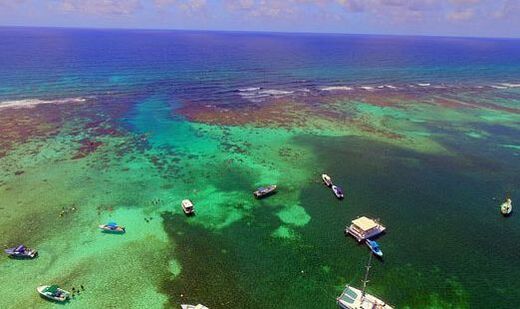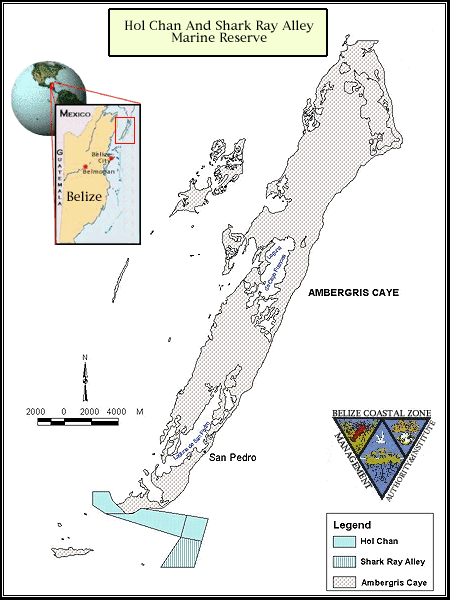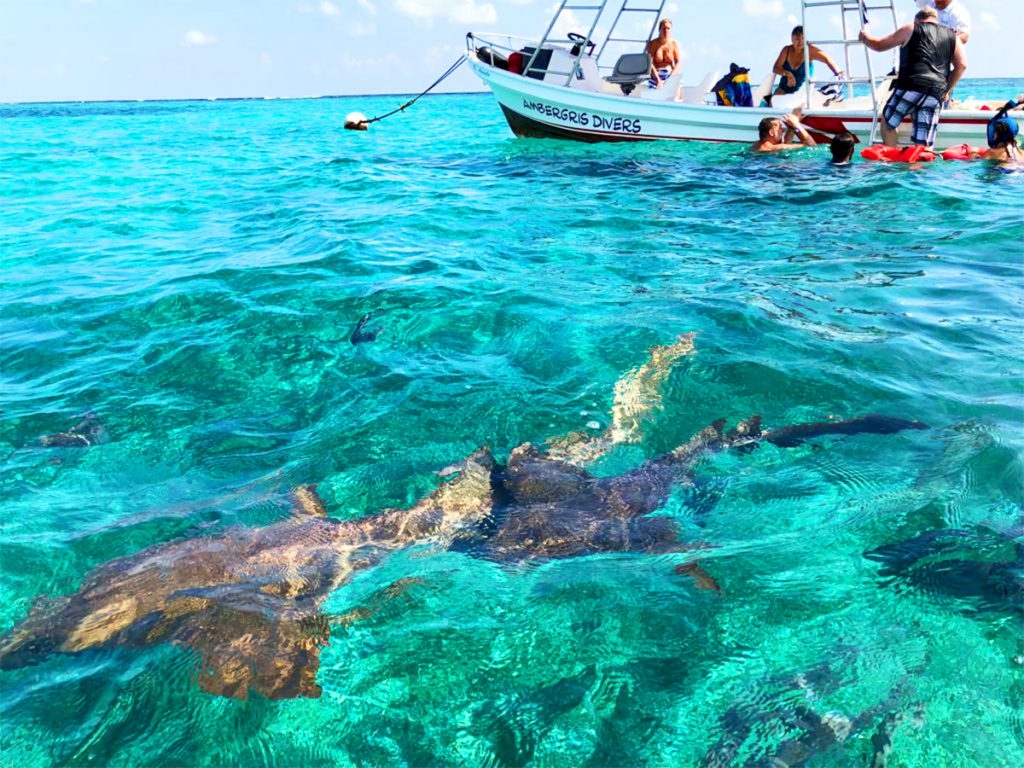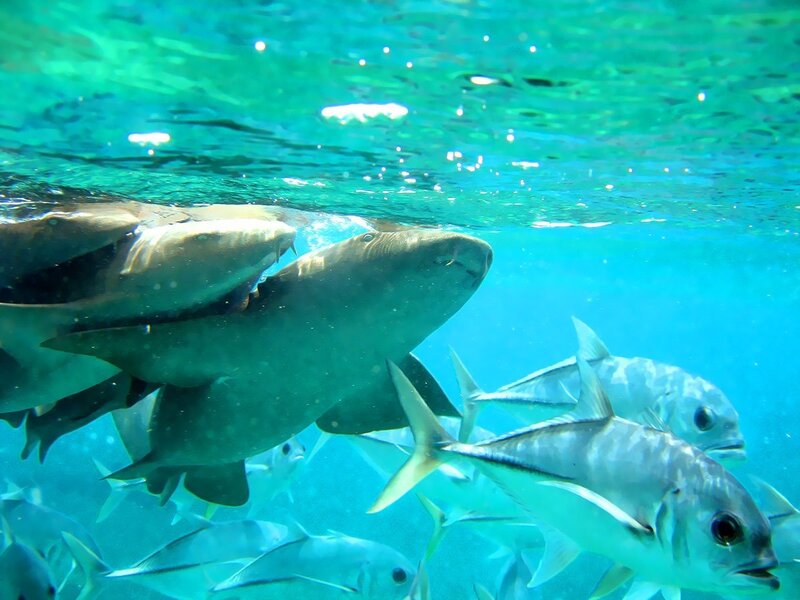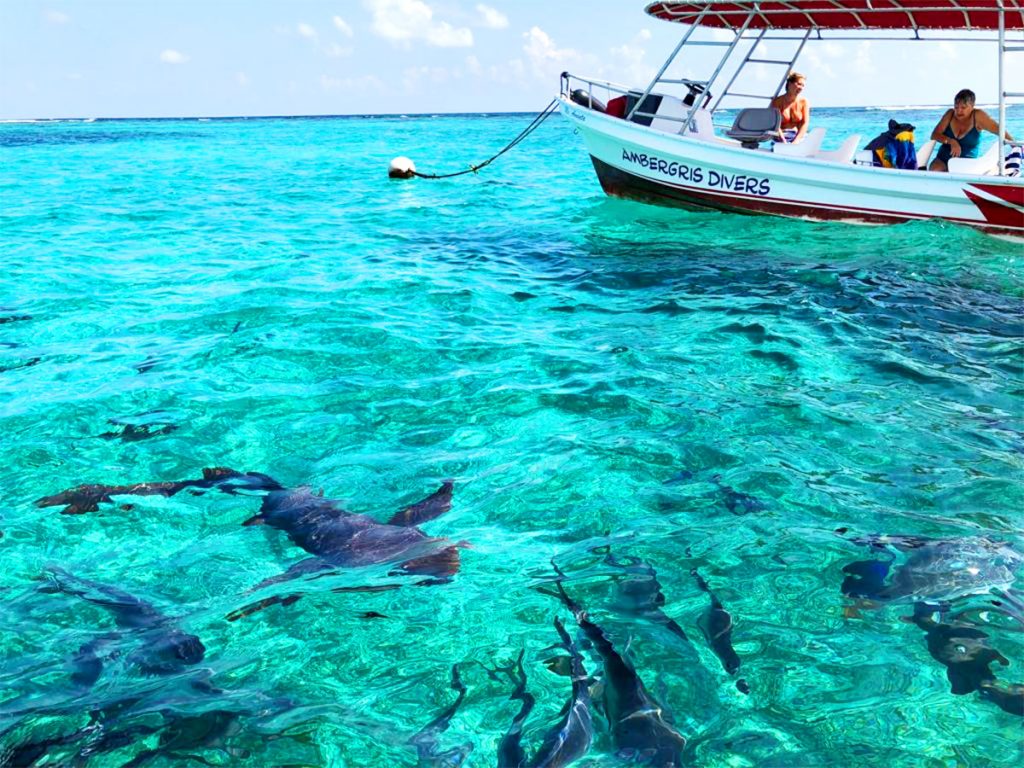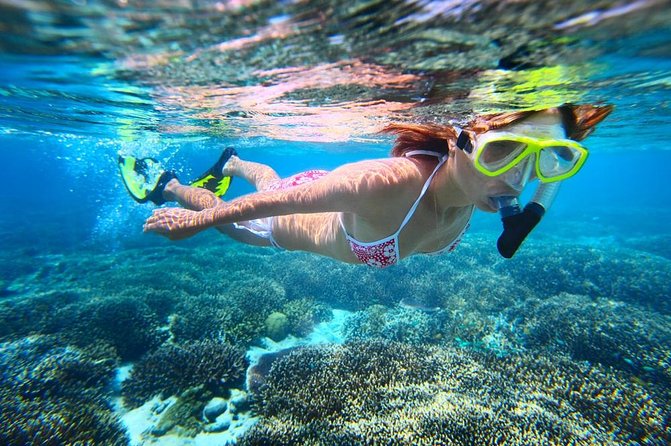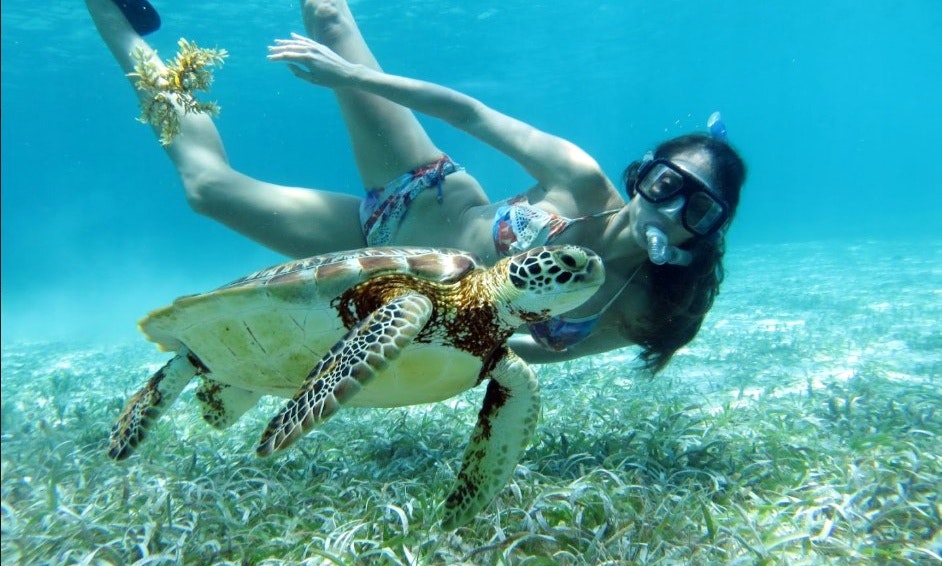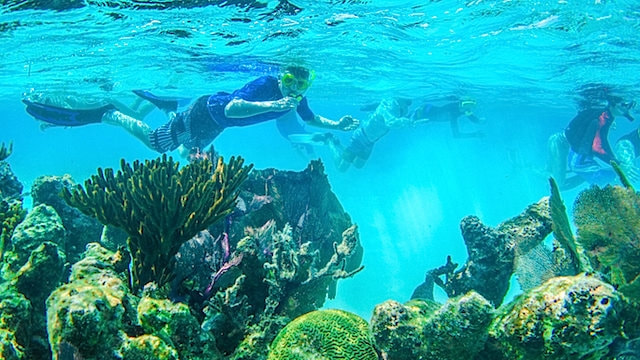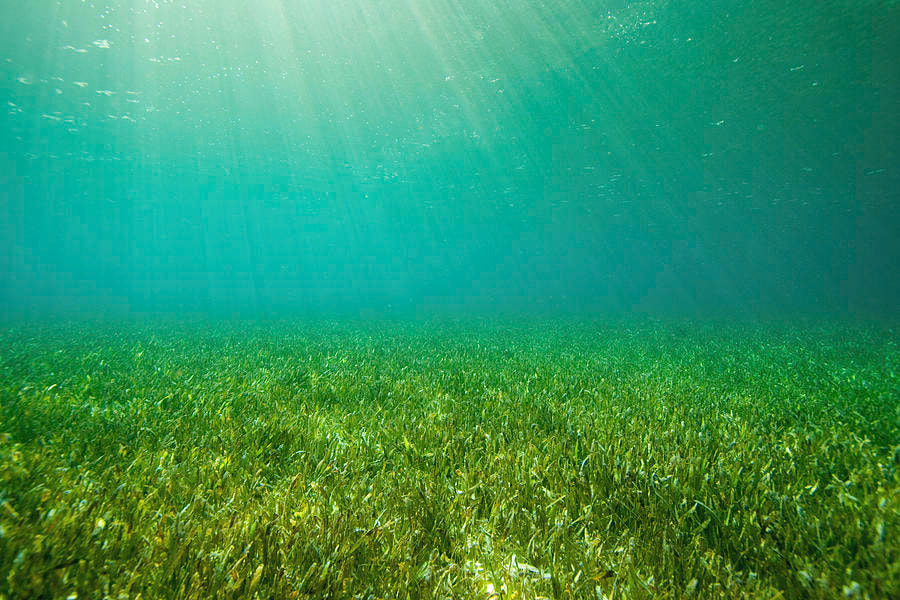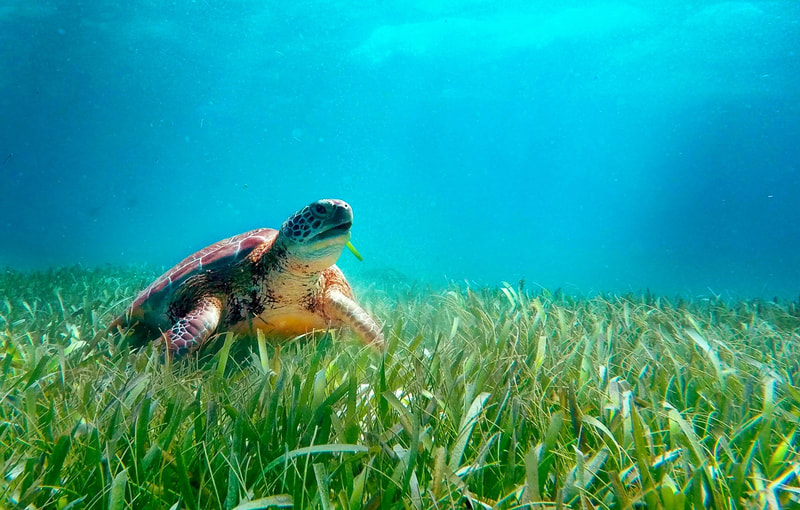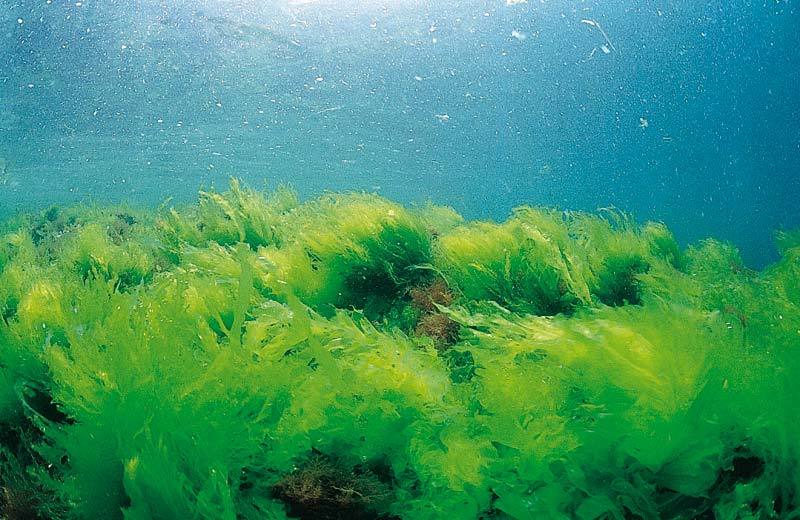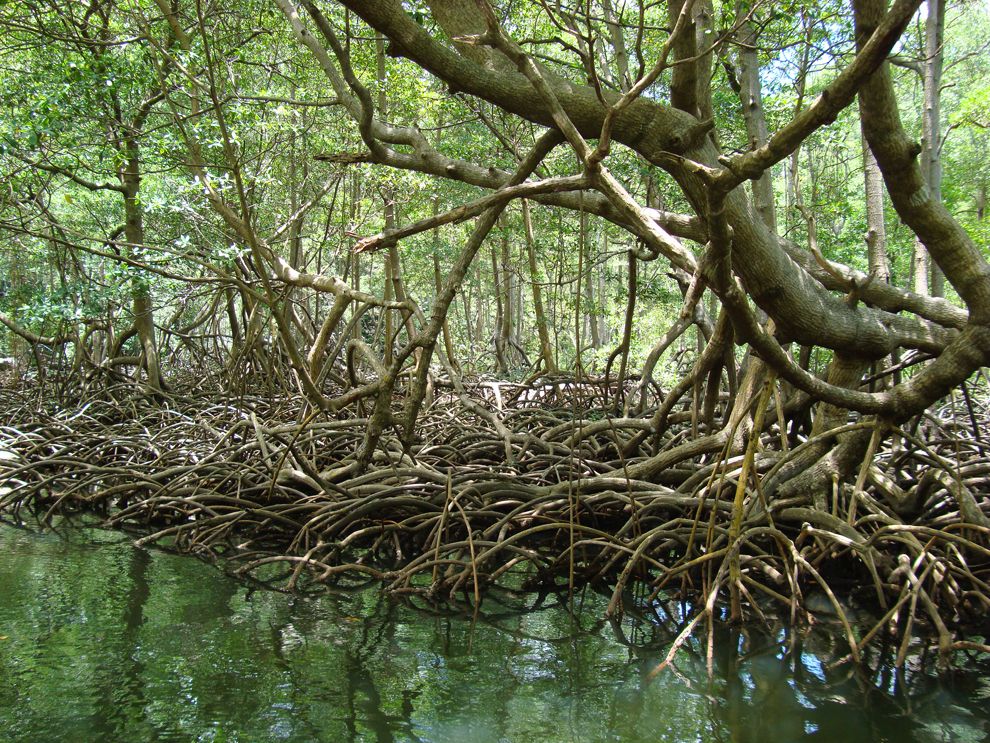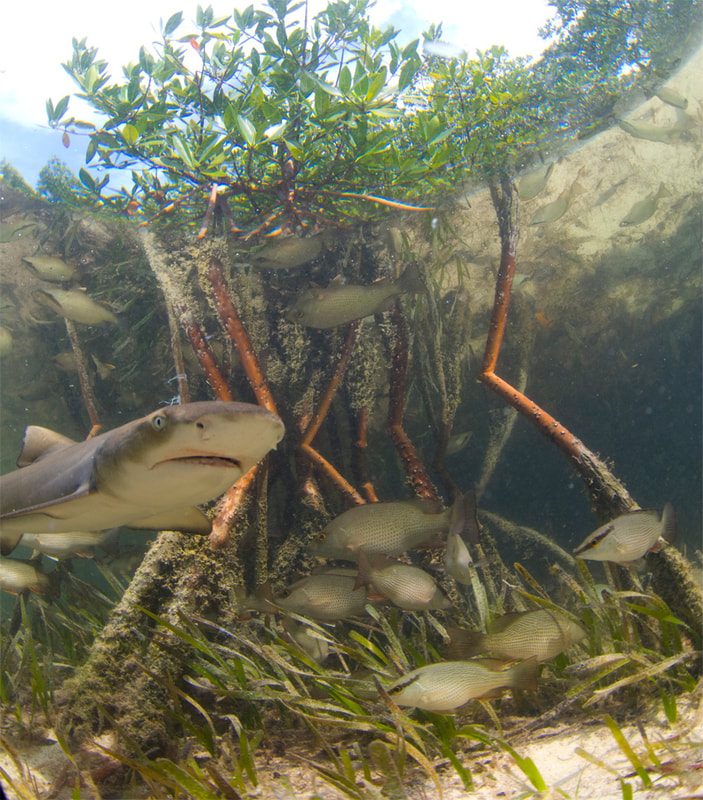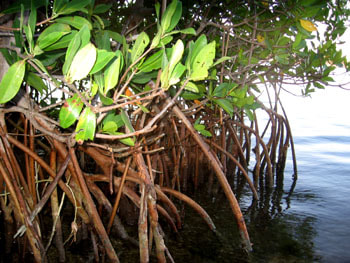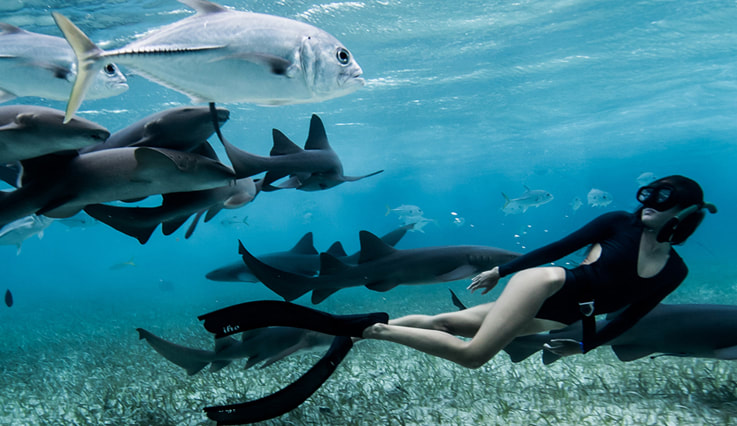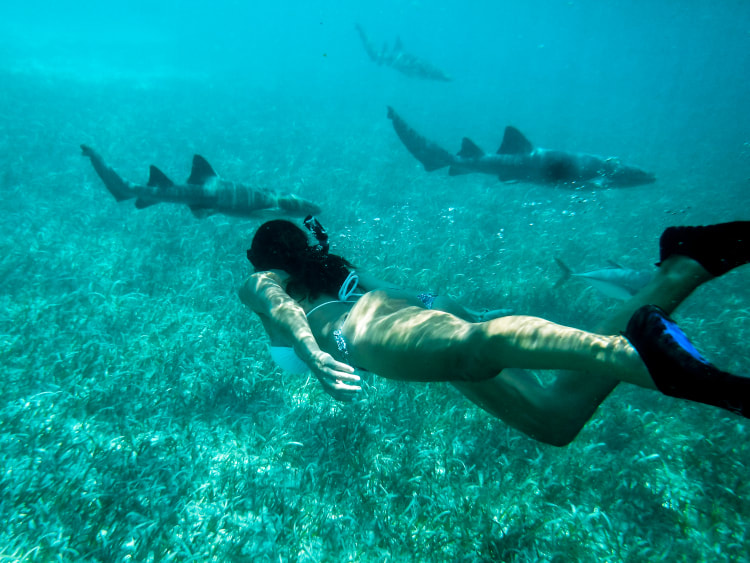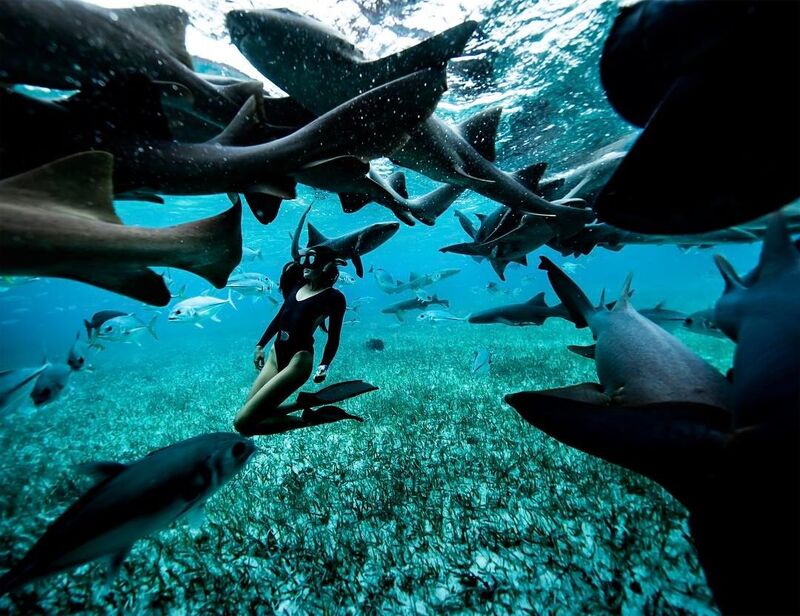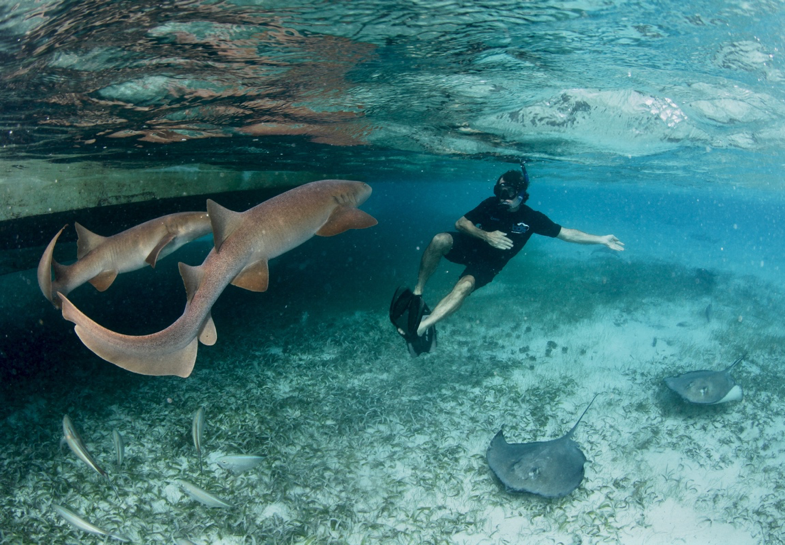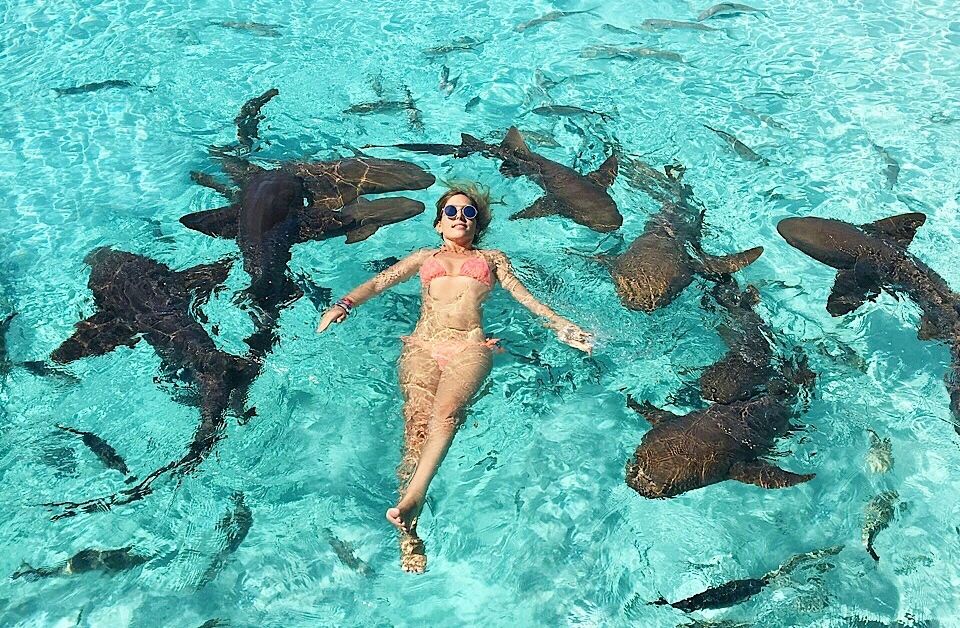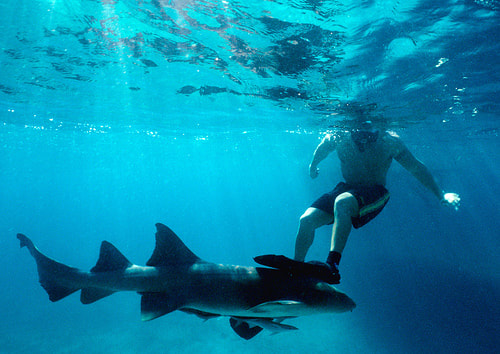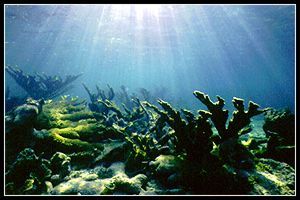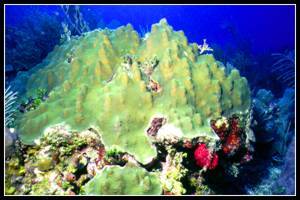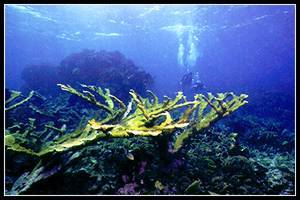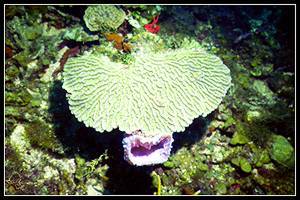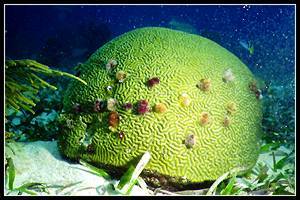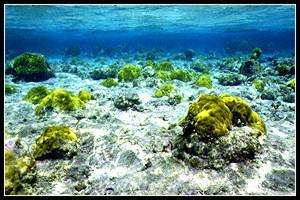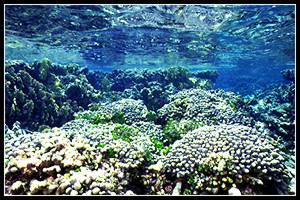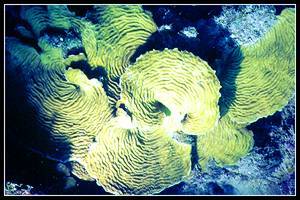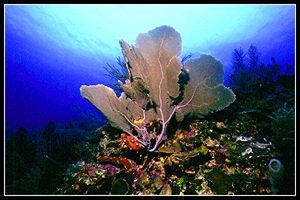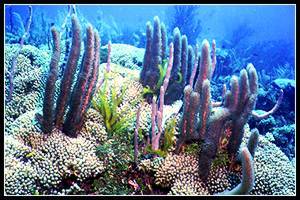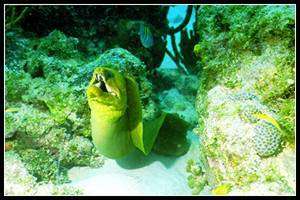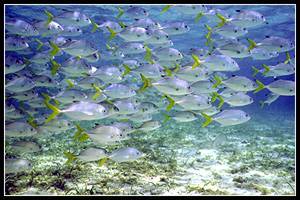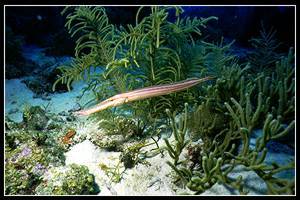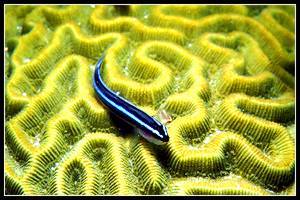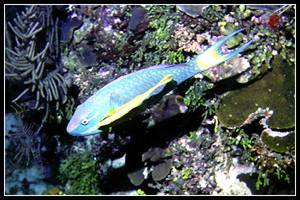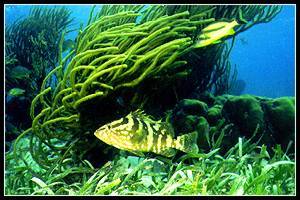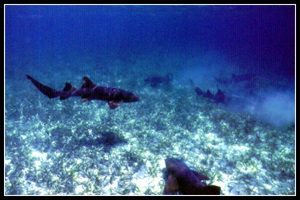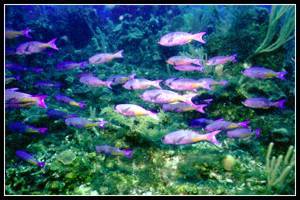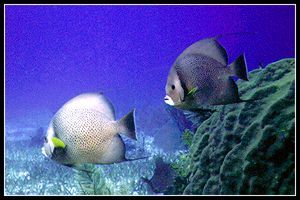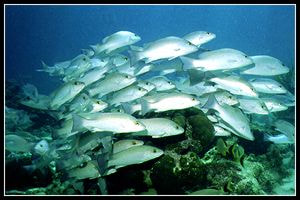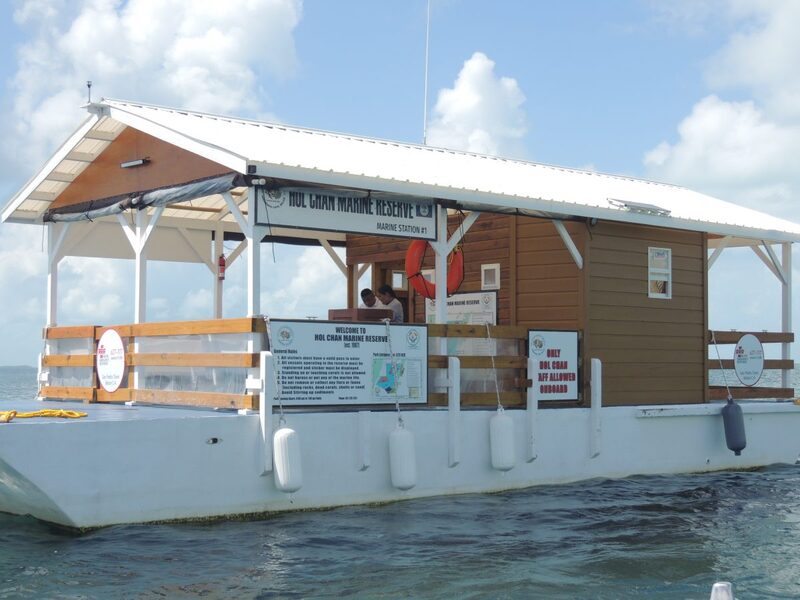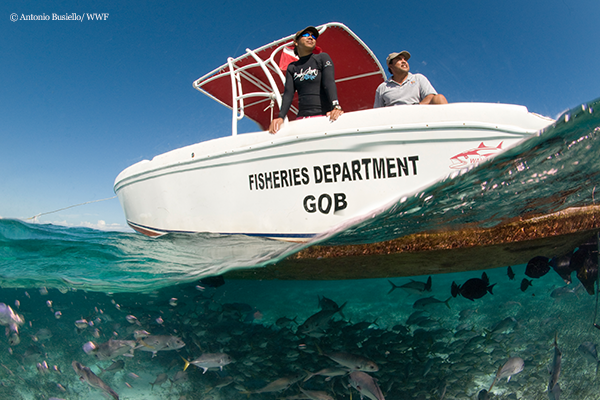HOL CHAN MARINE RESERVE
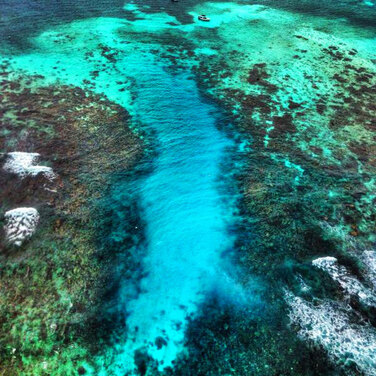
- The Hol Chan Marine Reserve and Shark Ray Alley is a marine reserve close to Ambergris Caye & Caye Caulker, off the coast of Belize. It covers approximately 13,000 acres, with 4,448 acres of this being (zones A, B & C), the coral reefs, sea-grass beds, and mangrove forest. It is the most popular diving/snorkeling sites in all of Belize. The reason for its popularity, is due to its close proximity to Ambergris Caye and Caye Caulker. It's located off the southern tip of Ambergris Caye, and is the oldest marine reserve in Belize.
- The entire park focuses on a cut through the reef (called quebrada) which is a little more than 25 yards wide, 30 feet deep, and 3 miles southwest of San Pedro. Because this is a protected marine reserve, you will be able to see a great abundance of fish and marine life. Hol Chan is a Maya word, meaning "Little Channel". Hol Chan offers a huge diversity of marine life encountered throughout the 4 zones of the park, not to mention the excitement and novelty of swimming with large numbers of nurse sharks and sting rays.
|
HOL CHAN MARINE RESERVE
Hol Chan Marine Reserve, is the oldest marine reserve in Belize. The reserve is located approximately 3 miles off the coast of Ambergris Caye and Caye Caulker and is considered the most popular snorkeling spot in Belize. By boat, Hol Chan is about 15 minutes away from San Pedro and 30 minutes away from Caye Caulker. Trips from San Pedro last about half day, while trips from Caye Caulker last a full day, including a visit to San Pedro. The reason why the site is popular for snorkeling and diving is because it has a abundance of marine wildlife. On a typical day, you can expect to see numerous types of fish, sea turtles, manta rays, crabs, eels, lobsters and friendly nurse sharks. Because the waters of the Hol Chan Marine Reserve are protected from commercial fishing and industrial exploitation, hundreds of aquatic species flourish here, including three kinds of coral, anemones and a colorful assortment of fauna, two species of sea turtle, large schools of fish like grouper and playful nurse sharks. Snorkeling in the Hol Chan Marine Reserve provides a view of the healthy coral reefs that provide habitat to a variety of marine life. While snorkeling Hol Chan, you may encounter sea turtles, southern stingrays, spotted eagle rays, nurse sharks and small reef fish. |
MARINE RESERVE ZONES
First established in 1987, today Hol Chan measures more than 13,000 acres (3 square miles) and is divided into four (4) distinct marine zones:
All four zones are clearly marked on the surface by byouys. Zone A through C each represents one of the major marine habitat types in Belize. Zone D was recently added as a location where nurse sharks and southern sting ray congregate. |
Hol Chan is Mayan for "Little Channel"
The reserve was formed primarily as a community-based initiative due to concern over the high level of uncontrolled, often destructive fishing and diving activities in the area. Reserve status was also called for by international organizations such as the New York Zoological Society (NYZS) and Peace Corps, due to the unique formation of the channel, the abundant fishery resources (including conch and lobster) and the feasibility of including an interlinked system of coral reef, seagrass and mangrove habitats in this area.
Due to the protected status of the area, the fish populations have exploded. In waters as shallow as 5 feet, large schools of jacks, groupers, snappers and barracuda abound. Along each side of the cut grow healthy stands of corals and sea grass in shallow water, perfect for the beginner snorkeler. The more experienced swimmer can swim from one side of the cut to the other, experiencing shallow reef drop offs over the steep sides of the "cut", and sea grass and sand beds in the middle of the channel.
Realizing the importance of the coral reef community off Ambergris Caye Belize, the Government of Belize established the Hol Chan Marine Reserve on May 2, 1987. Shark Ray Alley was officially declared Zone "D" of the Hol Chan Marine Reserve on August 31, 1999. Due to its protected status, what was once a depleted fishing area has now been allowed to re-generate, providing an unparalleled diving-snorkeling experience for visitors and an important refuge for marine life along the northern section of the Belize Barrier Reef. Belize is bordered on the north by Mexico, on the wet and south by Guatemala, and on the east by the Caribbean Sea.
Outside the barrier reef, the ocean bottom gently slopes off into the Caribbean. All levels of diving can be accommodated here due to the variations in depth, from 30 to over 100 foot dives can be planned and executed. Spur and groove formations (hills of coral running parallel to valleys of sand) provide rich habitat for marine life. Spotted eagle rays and other pelagic creatures swim above the reef while the more cryptic life like lobsters and eels fill the holes and tunnels through the coral spurs.
The bottom composition in this area is mainly of coral canyons extending out like long fingers from the barrier reef. I prefer to refer to the coral composition in this area as "hard" corals, as opposed to "softer" corals such as sponges and gorgonians found along the walls on the outer atolls. This canyon phenomenon is caused by the motion of the water against the reef. Here you will find an abundance of HUGE fish. The Hol Chan dive is teeming with many of the fish overflow of the inside park and is colorful and highly interesting. It is not unusual in this area to spot schools of rays floating in the distance, or even schools of barracudas. The fish are pretty friendly and hang around out of curiosity. In fact, some are downright extroverts and may come right up to your mask to view you. Some of the fish are so friendly, they will stay around to be petted or may even come up and "kiss" your mask.
In and around the Hol Chan Marine Park area, is "The Wreck". The wreck is really a sunken barge about 30 feet long located in approximately 80 feet of water. The main feature of this dive though, is not necessarily the "wreck" but the fact that on this dive you are GUARANTEED to see sharks. A colony of curious nurse sharks make this wreck their home, as well as a friendly green moray eel that lives in the front part of the barge. Please DO NOT try to touch or feed the eel. Remember they are wild animals and they could mistakenly take your finger as a piece of food.
Nurse sharks are non aggressive sharks. They usually such in their food which primarily consists of crustaceans. Several sharks which we refer to as "grandpa-sized" sharks will circle you out of curiosity. They are just as curious about you, as you are about them. These are probably some of the friendliest sharks on planet earth, so enjoy them. There are not many places in the world, where you can enjoy diving with sharks circling around you.
As always, remember to respect all wildlife as being wild. Move slow and do not use fast jerking hand motions. Remember too, you are in their territory. Enjoy your dive, and bask in the pleasure and enjoyment of being on the same level with these awesome creatures. By governmental law, guests are no longer allowed to pet, hold or interact with nurse sharks. Respect these majestic creatures by ONLY viewing and observing them in their natural habitat.
It is necessary to use common sense and check with local knowledge prior to diving the Hol Chan Channel. During times of maximum tidal flow, the currents can be too strong to swim against. Whenever snorkeling in Belize, and especially at Hol Chan, it is essential that you have a good pair of fins and mask.
SPECIAL NOTE: When trying to surface, do so "inside" the park area, where waters are calmer.
Due to the protected status of the area, the fish populations have exploded. In waters as shallow as 5 feet, large schools of jacks, groupers, snappers and barracuda abound. Along each side of the cut grow healthy stands of corals and sea grass in shallow water, perfect for the beginner snorkeler. The more experienced swimmer can swim from one side of the cut to the other, experiencing shallow reef drop offs over the steep sides of the "cut", and sea grass and sand beds in the middle of the channel.
Realizing the importance of the coral reef community off Ambergris Caye Belize, the Government of Belize established the Hol Chan Marine Reserve on May 2, 1987. Shark Ray Alley was officially declared Zone "D" of the Hol Chan Marine Reserve on August 31, 1999. Due to its protected status, what was once a depleted fishing area has now been allowed to re-generate, providing an unparalleled diving-snorkeling experience for visitors and an important refuge for marine life along the northern section of the Belize Barrier Reef. Belize is bordered on the north by Mexico, on the wet and south by Guatemala, and on the east by the Caribbean Sea.
Outside the barrier reef, the ocean bottom gently slopes off into the Caribbean. All levels of diving can be accommodated here due to the variations in depth, from 30 to over 100 foot dives can be planned and executed. Spur and groove formations (hills of coral running parallel to valleys of sand) provide rich habitat for marine life. Spotted eagle rays and other pelagic creatures swim above the reef while the more cryptic life like lobsters and eels fill the holes and tunnels through the coral spurs.
The bottom composition in this area is mainly of coral canyons extending out like long fingers from the barrier reef. I prefer to refer to the coral composition in this area as "hard" corals, as opposed to "softer" corals such as sponges and gorgonians found along the walls on the outer atolls. This canyon phenomenon is caused by the motion of the water against the reef. Here you will find an abundance of HUGE fish. The Hol Chan dive is teeming with many of the fish overflow of the inside park and is colorful and highly interesting. It is not unusual in this area to spot schools of rays floating in the distance, or even schools of barracudas. The fish are pretty friendly and hang around out of curiosity. In fact, some are downright extroverts and may come right up to your mask to view you. Some of the fish are so friendly, they will stay around to be petted or may even come up and "kiss" your mask.
In and around the Hol Chan Marine Park area, is "The Wreck". The wreck is really a sunken barge about 30 feet long located in approximately 80 feet of water. The main feature of this dive though, is not necessarily the "wreck" but the fact that on this dive you are GUARANTEED to see sharks. A colony of curious nurse sharks make this wreck their home, as well as a friendly green moray eel that lives in the front part of the barge. Please DO NOT try to touch or feed the eel. Remember they are wild animals and they could mistakenly take your finger as a piece of food.
Nurse sharks are non aggressive sharks. They usually such in their food which primarily consists of crustaceans. Several sharks which we refer to as "grandpa-sized" sharks will circle you out of curiosity. They are just as curious about you, as you are about them. These are probably some of the friendliest sharks on planet earth, so enjoy them. There are not many places in the world, where you can enjoy diving with sharks circling around you.
As always, remember to respect all wildlife as being wild. Move slow and do not use fast jerking hand motions. Remember too, you are in their territory. Enjoy your dive, and bask in the pleasure and enjoyment of being on the same level with these awesome creatures. By governmental law, guests are no longer allowed to pet, hold or interact with nurse sharks. Respect these majestic creatures by ONLY viewing and observing them in their natural habitat.
It is necessary to use common sense and check with local knowledge prior to diving the Hol Chan Channel. During times of maximum tidal flow, the currents can be too strong to swim against. Whenever snorkeling in Belize, and especially at Hol Chan, it is essential that you have a good pair of fins and mask.
SPECIAL NOTE: When trying to surface, do so "inside" the park area, where waters are calmer.
Why should I consider visiting the Hol Chan Marine Reserve?
Hol Chan Marine Reserve offers some of the best snorkeling in the entire country of Belize. Because this is a protected marine reserve, fish and marine life have been able to multiply in great numbers. A typical snorkeling trip will allow you to see numerous shoals of fish, green eels, eagle rays, manta rays, sea turtles, giant gropers, octopus, and nurse sharks. There is an abundance of coral life, from brain corals, fan corals, stag-horn coral and tube corals. This is a very popular family adventure and children love it, because they are guaranteed to see and experience many wonderful things below the surface.
Hol Chan Marine Reserve offers some of the best snorkeling in the entire country of Belize. Because this is a protected marine reserve, fish and marine life have been able to multiply in great numbers. A typical snorkeling trip will allow you to see numerous shoals of fish, green eels, eagle rays, manta rays, sea turtles, giant gropers, octopus, and nurse sharks. There is an abundance of coral life, from brain corals, fan corals, stag-horn coral and tube corals. This is a very popular family adventure and children love it, because they are guaranteed to see and experience many wonderful things below the surface.
|
What is the best way to experience the Hol Chan Marine Reserve?
The best way to experience the Hol Chan Marine Reserve is to take a guided tour. Park fees apply, to help support the maintenance of the reserve and pay the salaries of rangers. This is a half day tour (lasting about 3-4 hours). Tours can be purchased by any licensed tour operator on Ambergris Caye or Caye Caulker. |
Where is the Hol Chan Marine Reserve located?
Hol Chan Marine Reserve is located about 3 miles off the coast of Ambergris Caye, and is a natural cut in the Belize Barrier Reef. It's about a 15 minute boat ride from Ambergris Caye and a 40 minute boat ride from Caye Caulker. What is the best way to get to the Hol Chan Marine Reserve? The best way to get to the Hol Chan Marine Reserve is by boat. Boat tours are offered daily, and can be taken from either Ambergris Caye or Caye Caulker. |
Diving Hol Chan Marine Park - Bottom time 40 minutes at 70 feet
The Hol Chan Marine Park (Hol Chan is Mayan for Little Channel) is situated north of Caye Caulker. Declared the first marine park in the entire country of Belize,, this area has been zone a protected area. Due to its protected status, what was once a depleted fishing area has now been allowed to re-generate, producing to divers and snorkelers alike quite a colorful and varied fish spectacle.
The Hol Chan trip consists of two dives, both done outside the barrier reef area. Bottom composition in this area is mainly of coral canyons extending out like long fingers from the barrier reef. I prefer to refer to the coral composition in this area as "hard" corals, as opposed to the "softer" corals such as sponges and gorgonians found along the walls on the outer atolls. This canyon pehnomenon is caused by the motion of the water against the reef. On both dives today, you will note an abundance of HUGE fish. The Hol Chan dive is teeming with many of the fish overflow of the inside park and is colorful and highly interesting. It is not unusual in this area to spot schools of rays floating in the distance, or even schools of barracudas. The fish are pretty friendly and hand around out of curiosity. In fact, some are downright extroverts and may come right up to your mask to view you. Some of the fish are so friendly, they will stay around to be petted or may even come up and "kiss" your mask.
Surface interval between dives is done in the "inside" area of the park where calmer waters prevail. Have something to eat (or drink). Plunge into the shallow water and snorkel off for a bit and explore the awesome wonders of the shallow waters before the next dive.
The highlight of this dive trip to me, however, is the Wreck dive. The "wreck" is really a sunken barge about 30 feet long located in approximately 80 feet of water. The main feature of this dive, though, is not necessarily the "wreck" but the fact that on this dive you are GUARANTEED to see sharks. A colony of curious nurse sharks make this wreck their home, as well as a friendly green moray that lives in the front part of the barge. Pet the eel if you dare, but remember that these are still creatures of the wild. Several sharks which I refer to as "grandpa-sized" sharks will circle you. Enjoy them. There are not many places in the world where this will happen.
Since they only eat two divers a week, check before you book this trip. Okay, that was a joke. These are probably some of the friendliest sharks on planet earth. They have become accustomed to divers in the area and have become just as curious about you as you are about them. Please respect the wildlife. You are on their territory. Enjoy and bask in the pleasure and enjoyment of being on the same level with these awesome creatures.
The Hol Chan Marine Park (Hol Chan is Mayan for Little Channel) is situated north of Caye Caulker. Declared the first marine park in the entire country of Belize,, this area has been zone a protected area. Due to its protected status, what was once a depleted fishing area has now been allowed to re-generate, producing to divers and snorkelers alike quite a colorful and varied fish spectacle.
The Hol Chan trip consists of two dives, both done outside the barrier reef area. Bottom composition in this area is mainly of coral canyons extending out like long fingers from the barrier reef. I prefer to refer to the coral composition in this area as "hard" corals, as opposed to the "softer" corals such as sponges and gorgonians found along the walls on the outer atolls. This canyon pehnomenon is caused by the motion of the water against the reef. On both dives today, you will note an abundance of HUGE fish. The Hol Chan dive is teeming with many of the fish overflow of the inside park and is colorful and highly interesting. It is not unusual in this area to spot schools of rays floating in the distance, or even schools of barracudas. The fish are pretty friendly and hand around out of curiosity. In fact, some are downright extroverts and may come right up to your mask to view you. Some of the fish are so friendly, they will stay around to be petted or may even come up and "kiss" your mask.
Surface interval between dives is done in the "inside" area of the park where calmer waters prevail. Have something to eat (or drink). Plunge into the shallow water and snorkel off for a bit and explore the awesome wonders of the shallow waters before the next dive.
The highlight of this dive trip to me, however, is the Wreck dive. The "wreck" is really a sunken barge about 30 feet long located in approximately 80 feet of water. The main feature of this dive, though, is not necessarily the "wreck" but the fact that on this dive you are GUARANTEED to see sharks. A colony of curious nurse sharks make this wreck their home, as well as a friendly green moray that lives in the front part of the barge. Pet the eel if you dare, but remember that these are still creatures of the wild. Several sharks which I refer to as "grandpa-sized" sharks will circle you. Enjoy them. There are not many places in the world where this will happen.
Since they only eat two divers a week, check before you book this trip. Okay, that was a joke. These are probably some of the friendliest sharks on planet earth. They have become accustomed to divers in the area and have become just as curious about you as you are about them. Please respect the wildlife. You are on their territory. Enjoy and bask in the pleasure and enjoyment of being on the same level with these awesome creatures.
Hol Chan Marine Reserve - Wildlife
Hol Chan Cut is open to the sea beyond the reef, so allows marine creatures to travel from the outside of the reef to the inside and vice versa. Over 160 species of fish have been recorded in the reserve, along with forty types of coral, five species of sponge, two sea grasses, three species of sea turtle and three marine mammals: the short-beaked common dolphin, pantropical spotted dolphin and West Indian manatee. Spotted eagle rays and southern stingrays are common at the bottom of the channel. Lobsters, moray eels and sea anemones live among the rocky outcrops, and some of the many corals include brain coral, elkhorn coral, and finger coral. Jacks, groupers, snappers and barracuda are all common.
The mangrove forests act as nurseries for many fish species. Adult blue striped grunts, French grunts, white grunts, gray snappers, French angelfish, gray angelfish, and seahorses may also be found among the mangroves. The seagrass beds have parrotfish, hogfish, and occasional turtles. Manatees are rare visitors. Shark Ray Alley has nurse sharks, rays, and occasionally other fish.
Hol Chan Cut is open to the sea beyond the reef, so allows marine creatures to travel from the outside of the reef to the inside and vice versa. Over 160 species of fish have been recorded in the reserve, along with forty types of coral, five species of sponge, two sea grasses, three species of sea turtle and three marine mammals: the short-beaked common dolphin, pantropical spotted dolphin and West Indian manatee. Spotted eagle rays and southern stingrays are common at the bottom of the channel. Lobsters, moray eels and sea anemones live among the rocky outcrops, and some of the many corals include brain coral, elkhorn coral, and finger coral. Jacks, groupers, snappers and barracuda are all common.
The mangrove forests act as nurseries for many fish species. Adult blue striped grunts, French grunts, white grunts, gray snappers, French angelfish, gray angelfish, and seahorses may also be found among the mangroves. The seagrass beds have parrotfish, hogfish, and occasional turtles. Manatees are rare visitors. Shark Ray Alley has nurse sharks, rays, and occasionally other fish.
Hol Chan Marine Reserve - Features
Nurse sharks and Southern stingrays are a draw for tourists. Zone A mostly consists of the Hol Chan Cut, a natural break in the reef. The cut is approximately 75 feet wide and 30 feet deep (Hol Chan is Mayan for "little channel"), and is rich in marine life. Around the cut the sea can be as shallow 5 feet. On the outside of the reef the channel slopes into the Caribbean, and on the inside of the reef tails off into the shallows. Zone B has Boca Ciega Blue Hole, a sinkhole, which opens into a larger underwater cavern. It is dangerous for inexperienced divers, so is not regularly visited. Zone D, Shark Ray Alley, is a shallow sandy-bottomed area inside the reef, unremarkable except that it is a gathering place for sharks and stingrays. It was an area traditionally used by fishermen to clean their nets before returning to port, and the abundance of food that entered the water as a result attracted the sharks and rays to feed. The presence of these fish was actively encouraged as a tourist attraction — being fed by local tour guides; the shallow clear waters make it an ideal spot for snorkelers to observe the creatures.
Nurse sharks and Southern stingrays are a draw for tourists. Zone A mostly consists of the Hol Chan Cut, a natural break in the reef. The cut is approximately 75 feet wide and 30 feet deep (Hol Chan is Mayan for "little channel"), and is rich in marine life. Around the cut the sea can be as shallow 5 feet. On the outside of the reef the channel slopes into the Caribbean, and on the inside of the reef tails off into the shallows. Zone B has Boca Ciega Blue Hole, a sinkhole, which opens into a larger underwater cavern. It is dangerous for inexperienced divers, so is not regularly visited. Zone D, Shark Ray Alley, is a shallow sandy-bottomed area inside the reef, unremarkable except that it is a gathering place for sharks and stingrays. It was an area traditionally used by fishermen to clean their nets before returning to port, and the abundance of food that entered the water as a result attracted the sharks and rays to feed. The presence of these fish was actively encouraged as a tourist attraction — being fed by local tour guides; the shallow clear waters make it an ideal spot for snorkelers to observe the creatures.
Hol Chan Marine Reserve - History
In the early 1980s fish stocks in the area around Hol Chan began to dwindle and at the same time tourism to the Cayes began to increase. Disputes arose over access to the Hol Chan cut, a natural break in the reef, which was a productive fishing area but also popular with snorkelers and divers. Proposed fishing bans were rejected and in the mid 1980s public consultation over establishing a marine protected area began. Reserve status was also called for by international organizations such as the New York Zoological Society (NYZS) and Peace Corps, due to the unique formation of the channel, the abundant fishery resources (including conch and lobster) and the feasibility of including an interlinked system of coral reef, sea grass and mangrove habitats in this area.
Between 1985 and 1987, Janet Gibson worked to establish the a protected reserve campaigning with citizens, businesses, fishermen, and the government of Belize and educating them on the need for the project. In 1986, she wrote the Hol Chan Marine Reserve Draft Management Plan to develop the feasibility for the project. Based on environmentalist's efforts, the reserve was established in July 1987 with funding from WWF and USAID, after the draft management plan was approved by the Fisheries ministry and the local fishermen's co-operative. Active enforcement of the regulations began in 1989 and charging for entrance to Zone A started in 1990. The reserve was originally divided into three areas:
In the early 1980s fish stocks in the area around Hol Chan began to dwindle and at the same time tourism to the Cayes began to increase. Disputes arose over access to the Hol Chan cut, a natural break in the reef, which was a productive fishing area but also popular with snorkelers and divers. Proposed fishing bans were rejected and in the mid 1980s public consultation over establishing a marine protected area began. Reserve status was also called for by international organizations such as the New York Zoological Society (NYZS) and Peace Corps, due to the unique formation of the channel, the abundant fishery resources (including conch and lobster) and the feasibility of including an interlinked system of coral reef, sea grass and mangrove habitats in this area.
Between 1985 and 1987, Janet Gibson worked to establish the a protected reserve campaigning with citizens, businesses, fishermen, and the government of Belize and educating them on the need for the project. In 1986, she wrote the Hol Chan Marine Reserve Draft Management Plan to develop the feasibility for the project. Based on environmentalist's efforts, the reserve was established in July 1987 with funding from WWF and USAID, after the draft management plan was approved by the Fisheries ministry and the local fishermen's co-operative. Active enforcement of the regulations began in 1989 and charging for entrance to Zone A started in 1990. The reserve was originally divided into three areas:
- Zone A which includes the inside and outside of the reef (part of the Belize Barrier Reef). No fishing is permitted in this area, but snorkeling and diving are permitted on payment of a fee.
- Zone B covers the sea grass beds inside the reef. Both commercial and sport fishing are allowed in this area with a license.
- Zone C covers the mangroves swamps of southern Ambergris Caye. No commercial fishing is allowed in this zone, but sport fishing may be carried out under license.
HOL CHAN MARINE RESERVE
Reserve Office located in San Pedro
Reserve Office located in San Pedro
Hol Chan Marine Reserve - Management & Conservation
The reserve is managed by the Hol Chan Marine Reserve Trust Fund Committee, which replaced the informal advisory committee which ran the reserve until 1994. The majority of the funds for the park's upkeep is generated from the fees charged to visitors for access to Zones A and D. These are not collected directly but instead via a yearly licensing scheme which applies to the boats of tour guides. Funding from the WWF ended in 1995. The establishment of the reserve in 1987 included four main goals. These were:
The reserve is managed by the Hol Chan Marine Reserve Trust Fund Committee, which replaced the informal advisory committee which ran the reserve until 1994. The majority of the funds for the park's upkeep is generated from the fees charged to visitors for access to Zones A and D. These are not collected directly but instead via a yearly licensing scheme which applies to the boats of tour guides. Funding from the WWF ended in 1995. The establishment of the reserve in 1987 included four main goals. These were:
- Preserving an area of the coral reef ecosystem
- Providing recreational and tourist services while maintaining the utility of the area for fisheries
- Providing an opportunity for education and research within the park
- Conserving genetic resources
ZONE A - Coral Reef
ZONE A - Coral Reef (Hol Chan Cut) - The Hol Chan Cut is only 15 minutes (4 miles) south of San Pedro and about 30 minutes north of Caye Caulker. Trips from San Pedro last about half day, while trips from Caye Caulker last a full day including a visit to San Pedro. During the boat ride to the park, keep an eye out for jumping rays and flying fish.
Due to the protected status of the area, the fish populations have exploded. In waters as shallow as 5 feet, large schools of jacks, groupers, snappers and barracuda abound. Along each side of the cut grow healthy stands or corals and sea-grass in shallow water, perfect for the beginner snorkeler. The more experienced swimmer can swim from one side of the cut to the other, experiencing shallow reef, drop offs over the steep sides of the "cut", and sea-grass and sand beds in the middle of the channel.
Outside the barrier reef, the ocean bottom gently slopes off into the Caribbean. All levels of diving can be accommodated here due to the variations in depth, from 30 to over 100 foot dives can be planned and executed Spur and groove formations (hills of coral running parallel to valleys of sand) provide rich habitat for marine life. Spotted eagle rays and other pelagic creatures swim above the reef while the more cryptic life like lobsters and eels fill the holes and tunnels through the coral spurs.
It is necessary to use common sense and check with local knowledge prior to diving the Hol Chan Channel. During times of maximum tidal flow, the currents can be too strong to swim against. Whenever snorkeling in Belize, and especially at Hol Chan, it is essential that you have a good pair of fins and mask.
Due to the protected status of the area, the fish populations have exploded. In waters as shallow as 5 feet, large schools of jacks, groupers, snappers and barracuda abound. Along each side of the cut grow healthy stands or corals and sea-grass in shallow water, perfect for the beginner snorkeler. The more experienced swimmer can swim from one side of the cut to the other, experiencing shallow reef, drop offs over the steep sides of the "cut", and sea-grass and sand beds in the middle of the channel.
Outside the barrier reef, the ocean bottom gently slopes off into the Caribbean. All levels of diving can be accommodated here due to the variations in depth, from 30 to over 100 foot dives can be planned and executed Spur and groove formations (hills of coral running parallel to valleys of sand) provide rich habitat for marine life. Spotted eagle rays and other pelagic creatures swim above the reef while the more cryptic life like lobsters and eels fill the holes and tunnels through the coral spurs.
It is necessary to use common sense and check with local knowledge prior to diving the Hol Chan Channel. During times of maximum tidal flow, the currents can be too strong to swim against. Whenever snorkeling in Belize, and especially at Hol Chan, it is essential that you have a good pair of fins and mask.
ZONE B - Seagrass Beds
ZONE B - Seagrass Beds - While much less visited, the sea grass beds of Zone B are well worth the visit if only for the novelty of what you might see. Sea grass beds are huge feeding grounds, and chances are that you will come upon huge sting rays feeding on the bottom, and schools of parrot fish and hogfish grazing on epiphytes growing on the sea grass. Though a very rare occurrence, it is even possible to view manatee feeding in the grass beds.
The best method of exploring the sea grass beds is to have your boat drop you off about 200 yards from the edge, and to slowly swim toward the center of the seabed area. Swim slow and swing your head from side to side. Much of the life in the grass beds is well camouflaged and cryptic, so you will have to key in on movement - a conch shell dropping as the snail reacts to your movement, a lizardfish darting to the surface to feed and then back down motionless, a sail fin blenny flagging. It is even worth your while to stop for a few minutes motionless and let the surroundings come alive.
Within the sea grass zone lies the Boca Ciega ("Blind Mouth") cave. This "blue hole" is a miniature versions of the famed Blue Hole at Lighthouse Reef. You must be a cave-certified SCUBA diver to enter Boca Ciega, and only attempt to explore it after contacting the Reserve Manager at the office in San Pedro and securing an experienced cave-certified guide. The cave is considered dangerous, even by some experienced cave divers, and visibility in the area is generally poor.
Finally while in the sea grass zone, keep an keen eye and ear out for passing boats. Since most snorkeling and diving actually take place at the Hol Chan Channel, many boats speed through the other parts of the park. You can hear the wine of an outboard motor from a long ways away.
The best method of exploring the sea grass beds is to have your boat drop you off about 200 yards from the edge, and to slowly swim toward the center of the seabed area. Swim slow and swing your head from side to side. Much of the life in the grass beds is well camouflaged and cryptic, so you will have to key in on movement - a conch shell dropping as the snail reacts to your movement, a lizardfish darting to the surface to feed and then back down motionless, a sail fin blenny flagging. It is even worth your while to stop for a few minutes motionless and let the surroundings come alive.
Within the sea grass zone lies the Boca Ciega ("Blind Mouth") cave. This "blue hole" is a miniature versions of the famed Blue Hole at Lighthouse Reef. You must be a cave-certified SCUBA diver to enter Boca Ciega, and only attempt to explore it after contacting the Reserve Manager at the office in San Pedro and securing an experienced cave-certified guide. The cave is considered dangerous, even by some experienced cave divers, and visibility in the area is generally poor.
Finally while in the sea grass zone, keep an keen eye and ear out for passing boats. Since most snorkeling and diving actually take place at the Hol Chan Channel, many boats speed through the other parts of the park. You can hear the wine of an outboard motor from a long ways away.
ZONE C - Mangroves
ZONE C - Mangroves - The Hol Chan Cut is only 15 minutes (4 miles) south of San Pedro and about 30 minutes north of Caye Caulker. Trips from San Pedro last about half day, while trips from Caye Caulker last a full day including a visit to San Pedro. During the boat ride to the park, keep an eye out for jumping rays and flying fish.
Due to the protected status of the area, the fish populations have exploded. In waters as shallow as 5 feet, large schools of jacks, groupers, snappers and barracuda abound. Along each side of the cut grow healthy stands or corals and sea-grass in shallow water, perfect for the beginner snorkeler. The more experienced swimmer can swim from one side of the cut to the other, experiencing shallow reef, drop offs over the steep sides of the "cut", and sea-grass and sand beds in the middle of the channel.
Outside the barrier reef, the ocean bottom gently slopes off into the Caribbean. All levels of diving can be accommodated here due to the variations in depth, from 30 to over 100 foot dives can be planned and executed Spur and groove formations (hills of coral running parallel to valleys of sand) provide rich habitat for marine life. Spotted eagle rays and other pelagic creatures swim above the reef while the more cryptic life like lobsters and eels fill the holes and tunnels through the coral spurs.
It is necessary to use common sense and check with local knowledge prior to diving the Hol Chan Channel. During times of maximum tidal flow, the currents can be too strong to swim against. Whenever snorkeling in Belize, and especially at Hol Chan, it is essential that you have a good pair of fins and mask.Within the sea-grass zone lies the Boca Ciega ("Bind Mouth") cave. This "blue hole" is a miniature version of the famed Blue Hole at Lighthouse Reef. You must be a cave-certified SCUBA diver to enter Boca Ciega, and only attempt to explore it after contacting the Reserve Manager at the office in San Pedro and securing an experienced cave-certified guide. The cave is considered dangerous, even by some experienced cave divers, and visibility in the area is generally poor.
Finally, while in the sea-grass and mangrove zones, keep a keen eye and ear out for passing boats. Since most snorkeling and diving activity take place at the Hol Chan Channel, many boats speed through the other parts of the park. You can hear the wine of an outboard motor from a long ways away.
The mangrove habitat, especially the mangrove root systems that extend into the tidal range of the area, are one of the most colorful and biologically diverse habitats for marine invertebrates. Be careful while swimming among the mangroves. Stay well back from the silt laden roots, or you will stir up debris clouding the water. Gently float in toward a colorful root and be amazed at the layer upon layer of life struggling for space on the roots.
Due to the protected status of the area, the fish populations have exploded. In waters as shallow as 5 feet, large schools of jacks, groupers, snappers and barracuda abound. Along each side of the cut grow healthy stands or corals and sea-grass in shallow water, perfect for the beginner snorkeler. The more experienced swimmer can swim from one side of the cut to the other, experiencing shallow reef, drop offs over the steep sides of the "cut", and sea-grass and sand beds in the middle of the channel.
Outside the barrier reef, the ocean bottom gently slopes off into the Caribbean. All levels of diving can be accommodated here due to the variations in depth, from 30 to over 100 foot dives can be planned and executed Spur and groove formations (hills of coral running parallel to valleys of sand) provide rich habitat for marine life. Spotted eagle rays and other pelagic creatures swim above the reef while the more cryptic life like lobsters and eels fill the holes and tunnels through the coral spurs.
It is necessary to use common sense and check with local knowledge prior to diving the Hol Chan Channel. During times of maximum tidal flow, the currents can be too strong to swim against. Whenever snorkeling in Belize, and especially at Hol Chan, it is essential that you have a good pair of fins and mask.Within the sea-grass zone lies the Boca Ciega ("Bind Mouth") cave. This "blue hole" is a miniature version of the famed Blue Hole at Lighthouse Reef. You must be a cave-certified SCUBA diver to enter Boca Ciega, and only attempt to explore it after contacting the Reserve Manager at the office in San Pedro and securing an experienced cave-certified guide. The cave is considered dangerous, even by some experienced cave divers, and visibility in the area is generally poor.
Finally, while in the sea-grass and mangrove zones, keep a keen eye and ear out for passing boats. Since most snorkeling and diving activity take place at the Hol Chan Channel, many boats speed through the other parts of the park. You can hear the wine of an outboard motor from a long ways away.
The mangrove habitat, especially the mangrove root systems that extend into the tidal range of the area, are one of the most colorful and biologically diverse habitats for marine invertebrates. Be careful while swimming among the mangroves. Stay well back from the silt laden roots, or you will stir up debris clouding the water. Gently float in toward a colorful root and be amazed at the layer upon layer of life struggling for space on the roots.
ZONE D - Shark Ray Alley
ZONE D - Shark Ray Alley - This recently discovered dive site has been selected as one of the seven best "animal dives" in the Caribbean SKIN DIVER MAGAZINE. For years, local fishermen cleaned their catch just inside the reef, to the south of Hol Chan Cut and Ambergris Caye. The fishermen soon noticed that the offal from cleaning fish was attracting Nurse Sharks and several Southern Sting Rays. When the dive operators of San Pedro found out, they quickly investigated. What they found was a bonanza, and "Shark-Ray Alley" quickly became a very popular site.
The sharks and rays hear the dive boats approaching and begin to school in anticipation of bait being thrown into the water. When you arrive, you will see the surface often boiling with rolling sharks and sting ray wings as they vie for the scraps.
These creatures have a great tolerance for divers and snorkelers. The rays, which have a "wing-span" of two to four feet, swim directly toward the divers, mouths often turned up hoping for a hand held tid-bit to be placed near their mouths. Other have learned to swim in circles around the divers, as if performing for food. The docile Nurse Sharks average four to six feet in length and can be a bit more aggressive than the sting rays.
It is important that you maintain your perspective. These are wild creatures first and as such, can be unpredictable in their behavior. The best course of action is to leave the touching and feeding to the dive masters, while you enjoy the show from a safe distance determined by your swimming skill and comfort level.
The boundaries of the Hol Chan Marine Reserve are marked by buoys. Signs, informing divers that they are entering a protected area, are erected at either end of the reserve near the reef crest. Below is a brief summary of regulations governing the water of the Park.
The sharks and rays hear the dive boats approaching and begin to school in anticipation of bait being thrown into the water. When you arrive, you will see the surface often boiling with rolling sharks and sting ray wings as they vie for the scraps.
These creatures have a great tolerance for divers and snorkelers. The rays, which have a "wing-span" of two to four feet, swim directly toward the divers, mouths often turned up hoping for a hand held tid-bit to be placed near their mouths. Other have learned to swim in circles around the divers, as if performing for food. The docile Nurse Sharks average four to six feet in length and can be a bit more aggressive than the sting rays.
It is important that you maintain your perspective. These are wild creatures first and as such, can be unpredictable in their behavior. The best course of action is to leave the touching and feeding to the dive masters, while you enjoy the show from a safe distance determined by your swimming skill and comfort level.
The boundaries of the Hol Chan Marine Reserve are marked by buoys. Signs, informing divers that they are entering a protected area, are erected at either end of the reserve near the reef crest. Below is a brief summary of regulations governing the water of the Park.
HOL CHAN MARINE RESERVE - Rules & Regulations
ZONE A - THE REEF CUT
ZONE B - THE SEAGRASS BEDS (Lagoon) THE MANGROVES
ADDITIONAL RULES & REGULATIONS
FAILURE TO OBSERVE REGULATIONS WILL RESULT IN A CONVICTION AND FINE. The fine will be a minimum of $1,000.00 or 6 months of imprisonment or both.
BOATING SAFETY
WATER SAFETY
- No fishing or collecting is permitted.
- Do not disturb or remove any flora or fauna.
- No persons shall cast or drag any anchor in such a way as to damage coral reef formations.
- Visitors shall first obtain a ticket from HCMR Office or from the ranger on duty before engaging in any water activities.
- All boats operating in this zone shall obtain registration from the Administrator.
ZONE B - THE SEAGRASS BEDS (Lagoon) THE MANGROVES
- No spearing or netting of fish is allowed in the Boca Ciega Blue Hole.
- Fishing can only be carried out under special license.
- All boats used for sport fishing shall obtain registration from the Administrator.
- Sports fishermen shall obtain tickets from the reserve office before engaging in any fish activities.
- The plants and wildlife on the mangrove cayes are not to be collected or disturbed.
ADDITIONAL RULES & REGULATIONS
- No person shall mark or tamper with any sign, buoy or notice installed by the Administrator.
- Eight divers/snorkelers per guide. When more than eight, one diver must join the group in the water.
- No touching or standing on corals.
- No feeding or touching of fish.
- Do not use gloves in reserve's waters.
- Use dive flag when people are in the water.
- Do not litter.
- An un-experienced snorkeler must wear a life jacket.
- The fisheries Regulations 1977 shall apply within the reserve.
FAILURE TO OBSERVE REGULATIONS WILL RESULT IN A CONVICTION AND FINE. The fine will be a minimum of $1,000.00 or 6 months of imprisonment or both.
BOATING SAFETY
- Approach the patrol boat and clear your tickets before engaging in any water activities.
- Use extreme caution when approaching the Hol Chan Channel. The concentration of snorkelers and divers in this area poses a greater potential for accidents. be sure to look keenly for bubbles and the tips of snorkels on the surface of the water.
- Motor slowly, in deep water, until a mooring buoy is selected. Idle directly to the buoy without meandering among other dive boats. Reserve this procedure when departing from the area.
- If a mooring boy is not available, anchor in the seagrass bed and be sure that your anchor chain or line does not contact any coral formations.
- Boaters, stop at least 100 yards from a "Divers Down Flag" and watch for bubbles.
- Glass-bottom boat operators should wait until the channel is completely free of snorkelers and divers before motoring through the channel.
- Bow riding is an unsafe boating practice. Do not allow your passengers to hang out of the boat while underway.
- Drinking and driving do not mix.
- Use caution when approaching a weed line. Large floating debris often found within the weed can cause damage to your prop or lower unit.
- Steer clear of marker buoys in the reserve.
- Every commercial and non-commercial vessels should carry a fire extinguisher, a first aid kit and communication equipment.
- Lastly, do enjoy your visit to the reserve and consider the safe boating tips outline above.
WATER SAFETY
- If it has been a while since you have SCUBA dived or snorkeled please let your guide know. He will assist you in attaining self confidence and practice.
- Make sure you follow the group and never stray by own self.
- Ask your guide about the currents or anything you may not be sure of. Be sure that you do not use faulty equipment.
- Take a buoyancy device if you are not sure of yourself in the water.
- Never interfere with any marine fauna or flora as these may cause harm to you just as you can cause harm to them.
- Do not take any organic matter to fee the fish as these may attract sharks and barracudas which can cause harm.
- Never attempt to do what may not be within your capabilities (i.e. swim long distances if not physically fit.
HOL CHAN MARINE PARK & SHARK RAY ALLEY
Rated one of the best animal dives in the Caribbean by Skin Diver Magazine.
|
|
|
